Devotion – Part 1: Myanmar
Chapter 3: Bago & Bagan
A short distance northeast of Yangon but still in Southern Myanmar is the city of Bago; in 2014 the population of Bago was more than 254,000. Mon language chronicles report widely divergent dates for the foundation of Bago ranging from 573 CE to 1152. The earliest evidence of the city still accessible dates only to the late Pagan period of 1212 to 1266. The Bago settlement grew in importance in the 14th century as the region became the center of the Mon-speaking kingdom.
In 1369 King Binnya U made Bago the capital. Later, Queen Shin Sawbu reigned peacefully until she chose the Buddhist monk Dhammazedi to succeed her in 1471. Under Dhammazedi, Bago became a center of commerce and Theravada Buddhism.
In 1519 António Correia, a Portugese merchant, landed in Bago looking for new markets for pepper and cochin, an Asian breed of chickens. As a major port city, Bago was frequently visited by Europeans who exclaimed its magnificence. The Portuguese took the city in 1599 after Bago’s destruction by kings of the Tangot and Arrakan regions.
Beginning in 1782 the city was rebuilt by King Bodawpaya; however, by then the river had shifted course and Bago was no longer accessible by the sea. The city never regained its previous importance.
When Bago was thriving the Shwemawdaw Paya, a pagoda of about twenty-one meters in height, was constructed sometime in the 10th century. In English the name means “Great Golden God.” The pagoda was destroyed several times by earthquakes, including major quakes in 1917 and 1930. The pagoda is one of Myanmar’s most sacred sites because it enshrines several relics of the Buddha.
There were several efforts to rebuild the pagoda. World War II and other difficulties interfered with ongoing reconstruction. U Nu, the first prime minister of Burma after its independence from Great Britain in 1948, began a restoration effort in 1951 that was completed a few years later. That reconstruction brought the pagoda to its current height of 114 meters, making it taller than the Shwedagon Pagoda and the tallest pagoda in Myanmar. Two gigantic Chinthe, mythological animals that look like lions, stand guard at the entrance to the temple grounds.
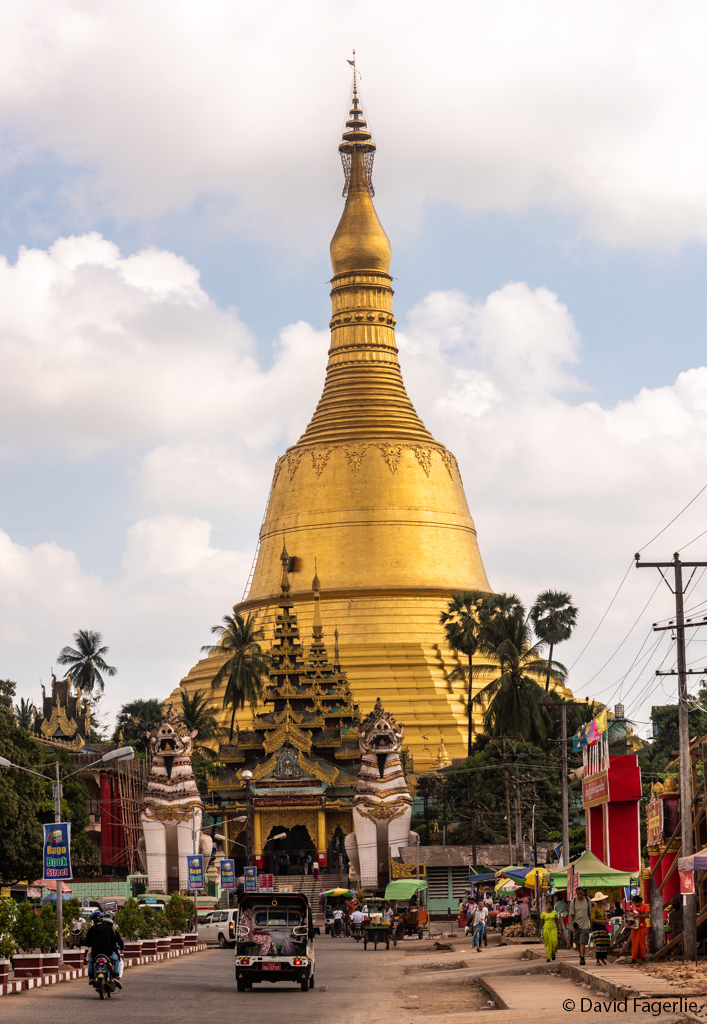
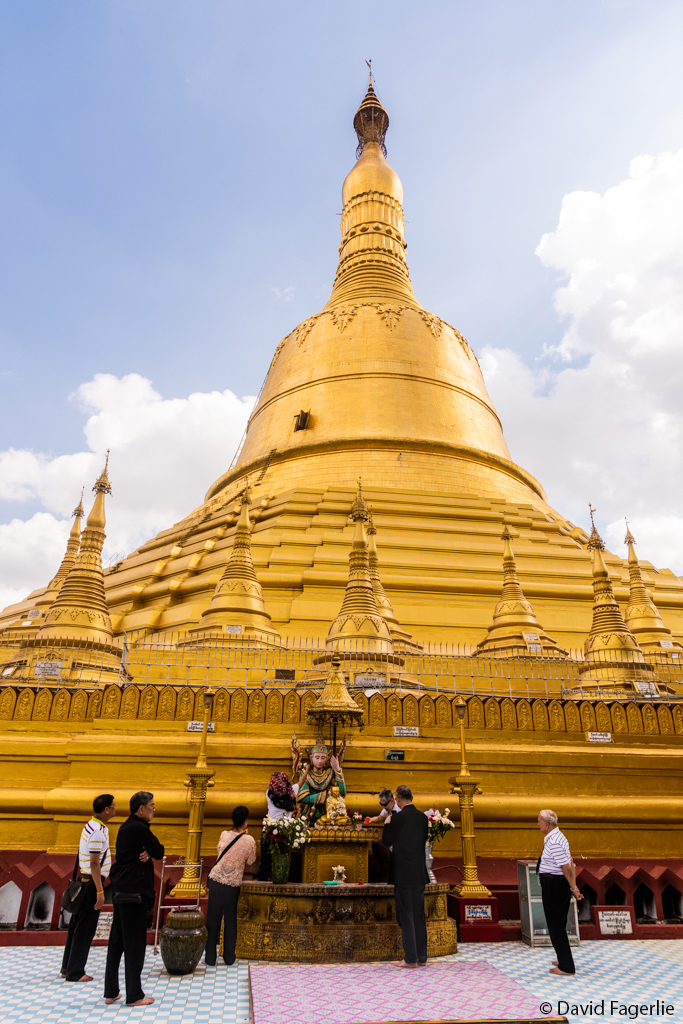
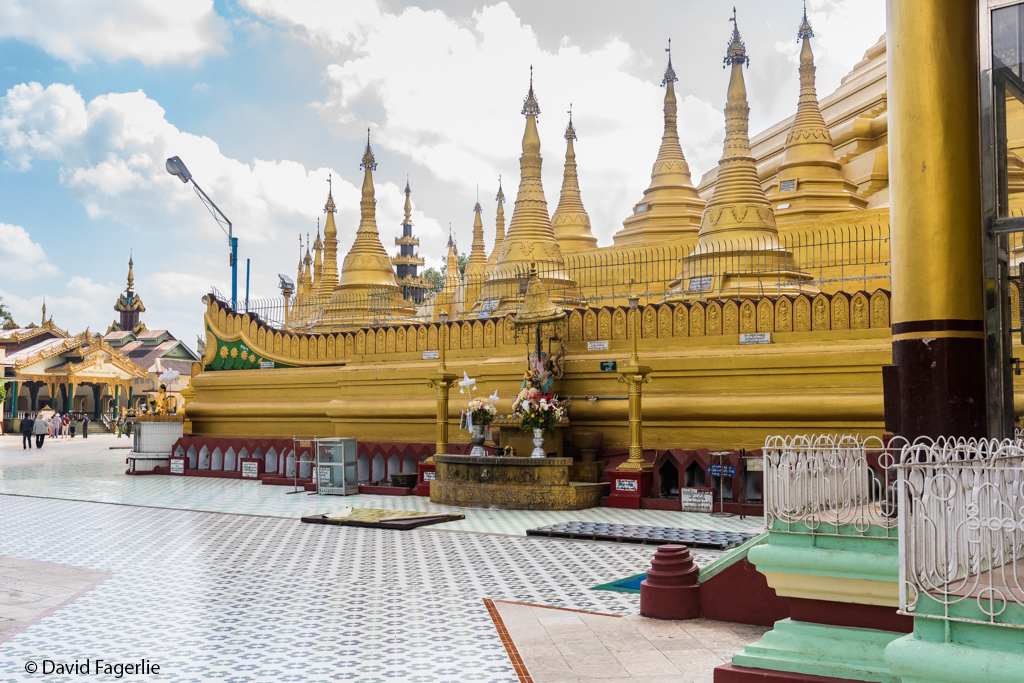
A portion of the pagoda that collapsed in the 1917 earthquake remains. It is a magnate for the faithful who come daily to touch it and insert wires between the bricks. I suppose the wires serve a similar purpose to that of gold leaf at other holy places?
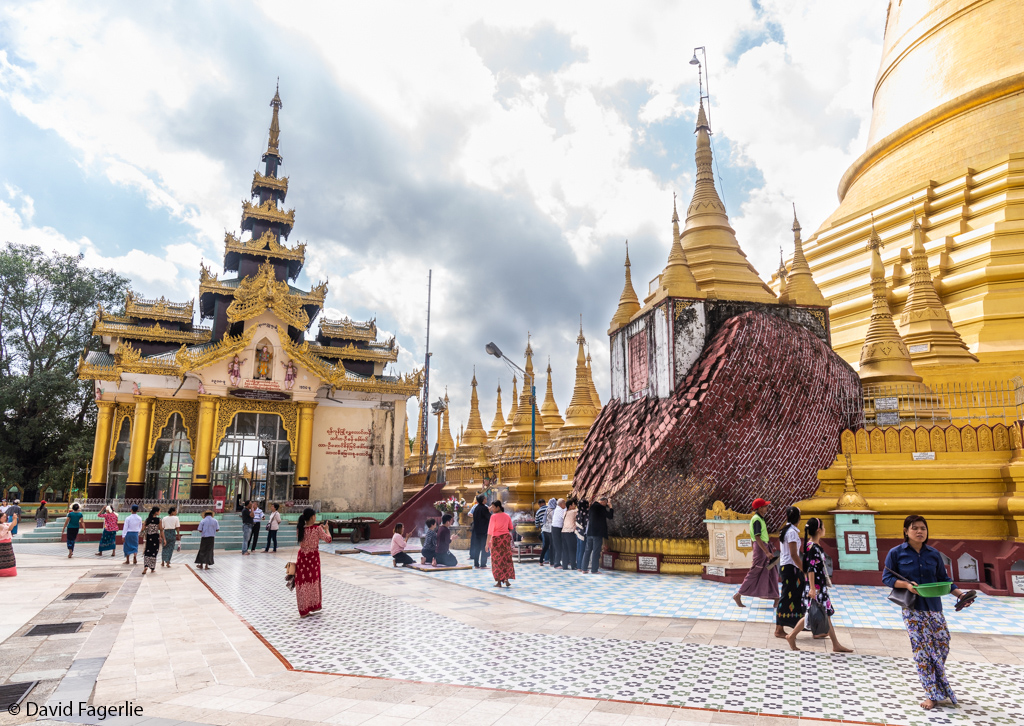
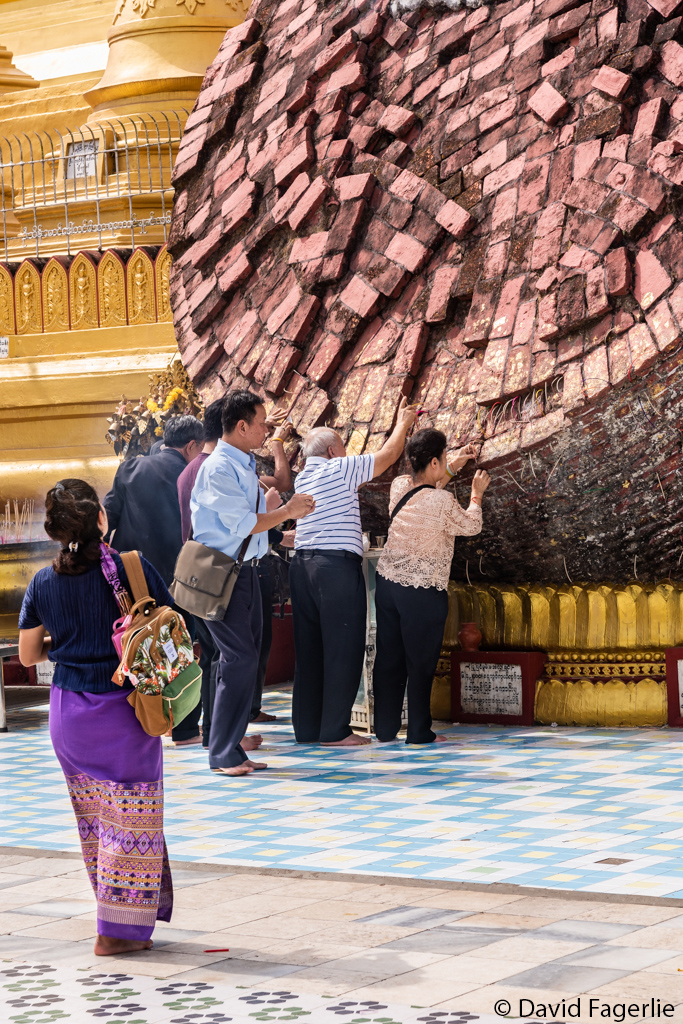
The pagoda is not popular with tourists; we were the only foreigners present.
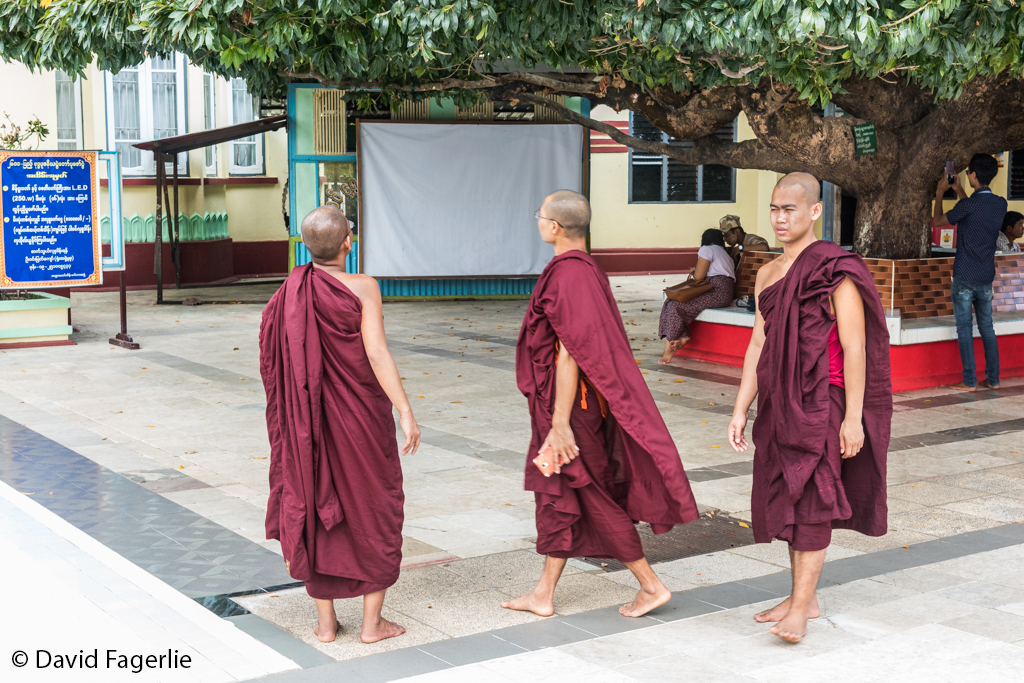
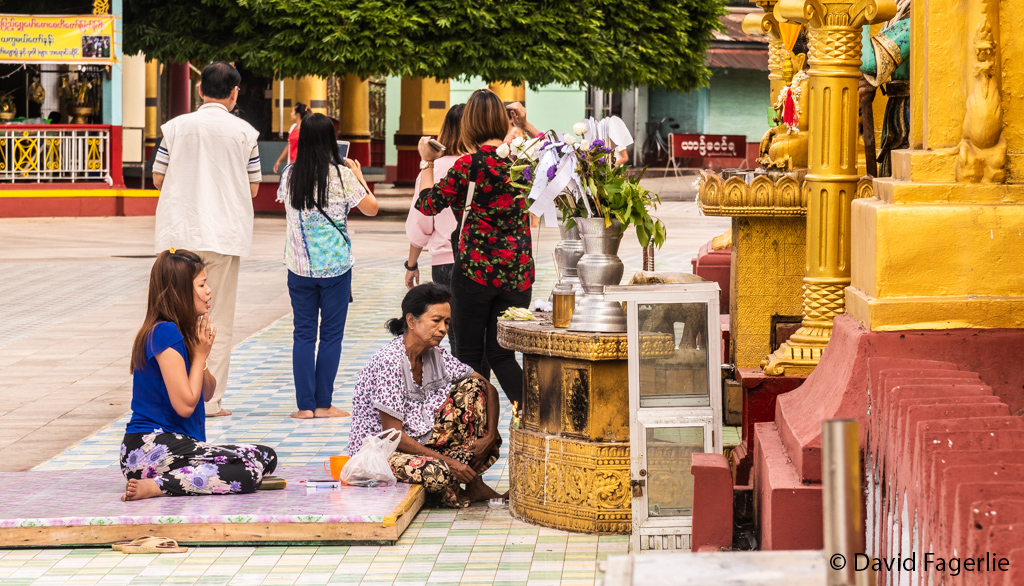
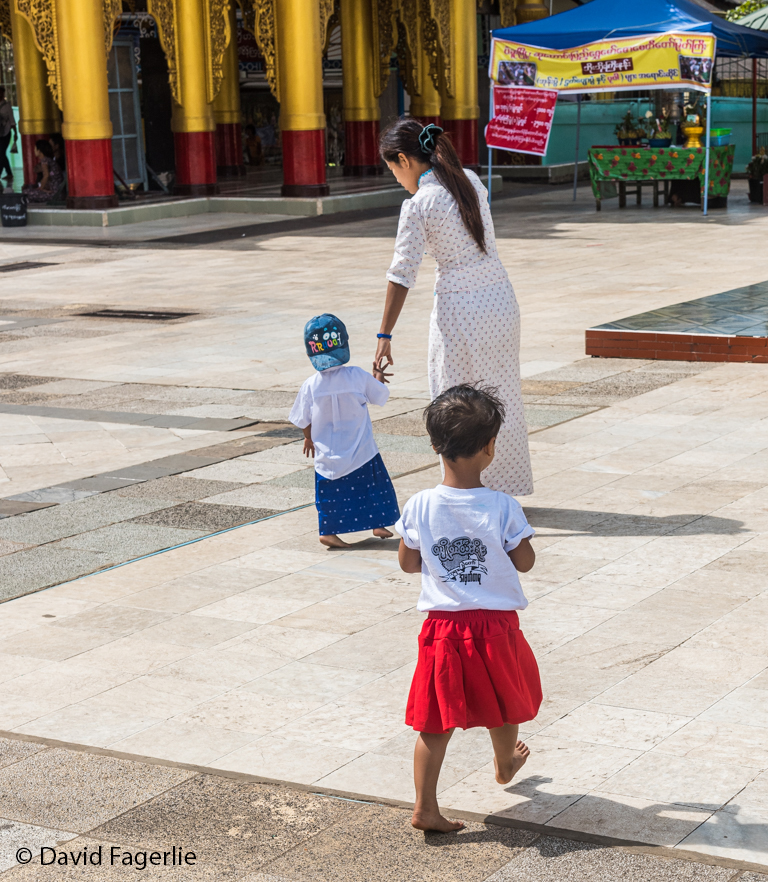
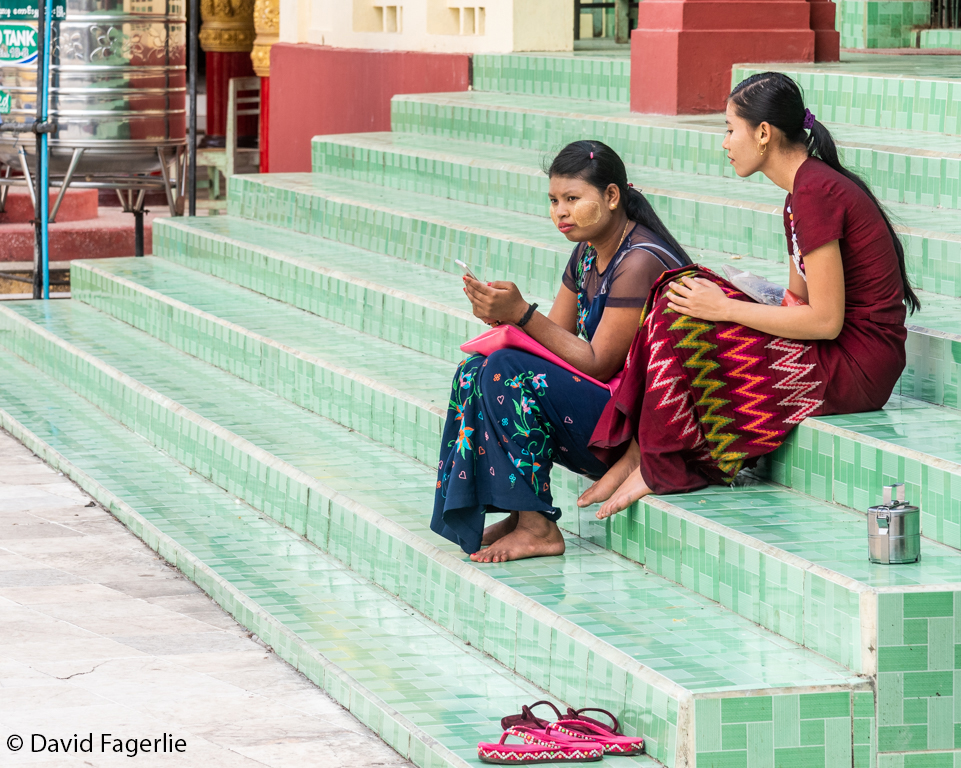
After visiting the Shwemandaw Paya we traveled a short distance to the nearby Shwethalyaung reclining Buddha. The 55 meters long and 16 meters high statue was believed to have been created in 994 CE during the reign of the Mon King Mingadeipka. The statue fell into disrepair and was then renovated by King Dhammazedi in the 15th century.
The statue was lost track of during the Mon revolt against the Burmese in 1757. It was rediscovered in 1880 under a cover of jungle growth when the British were building a railway from Yangon to Bago. Restoration began in 1881. The image depicts the Buddha just before his death and entering into Nirvana.
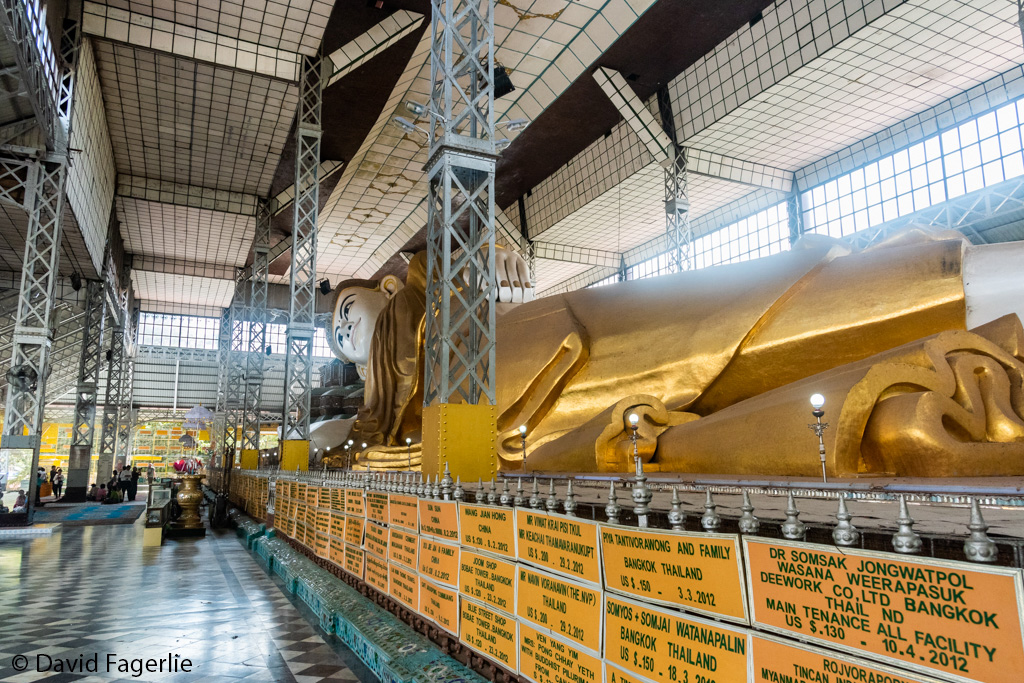

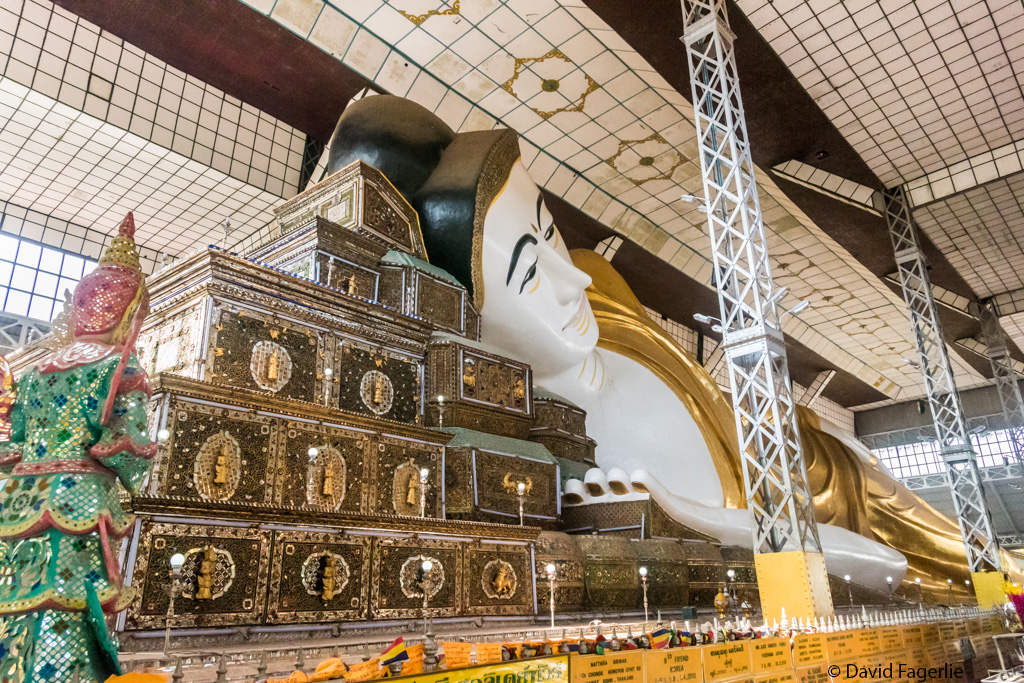
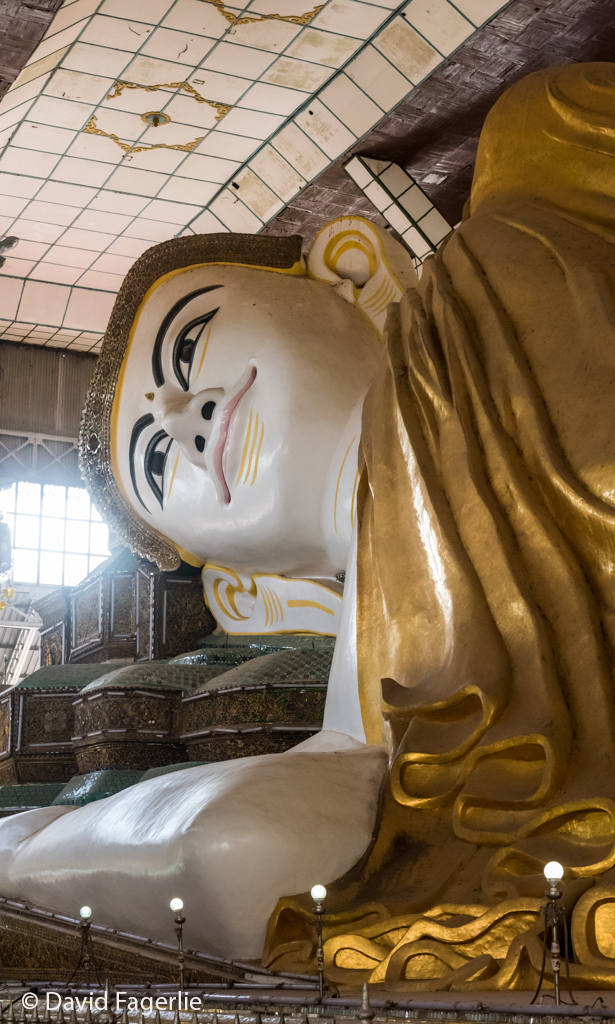
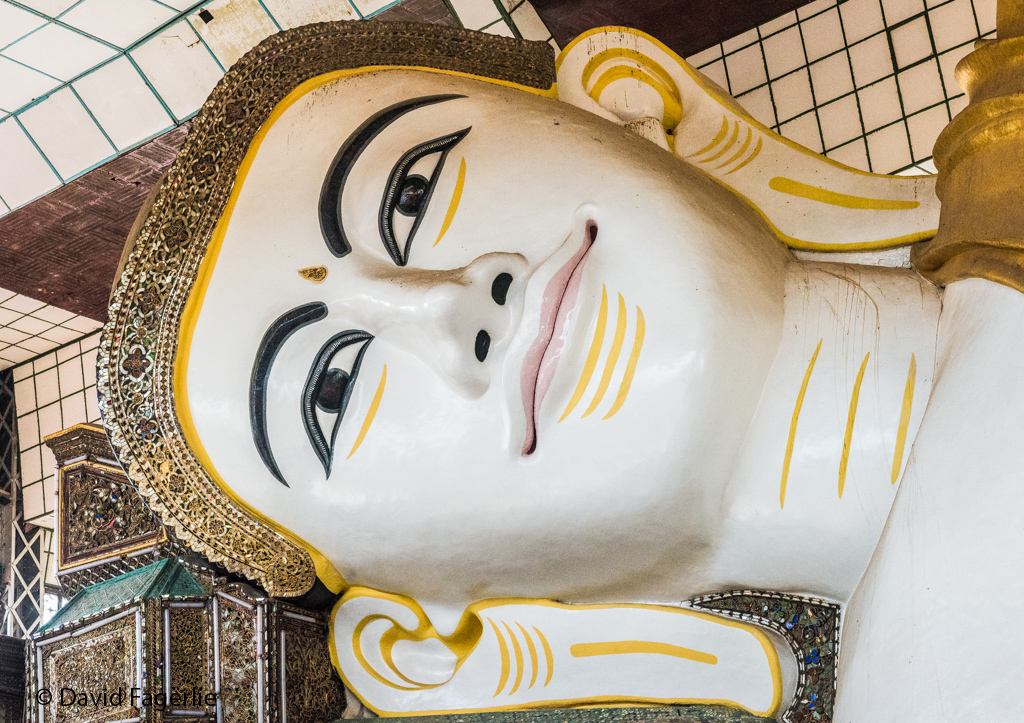
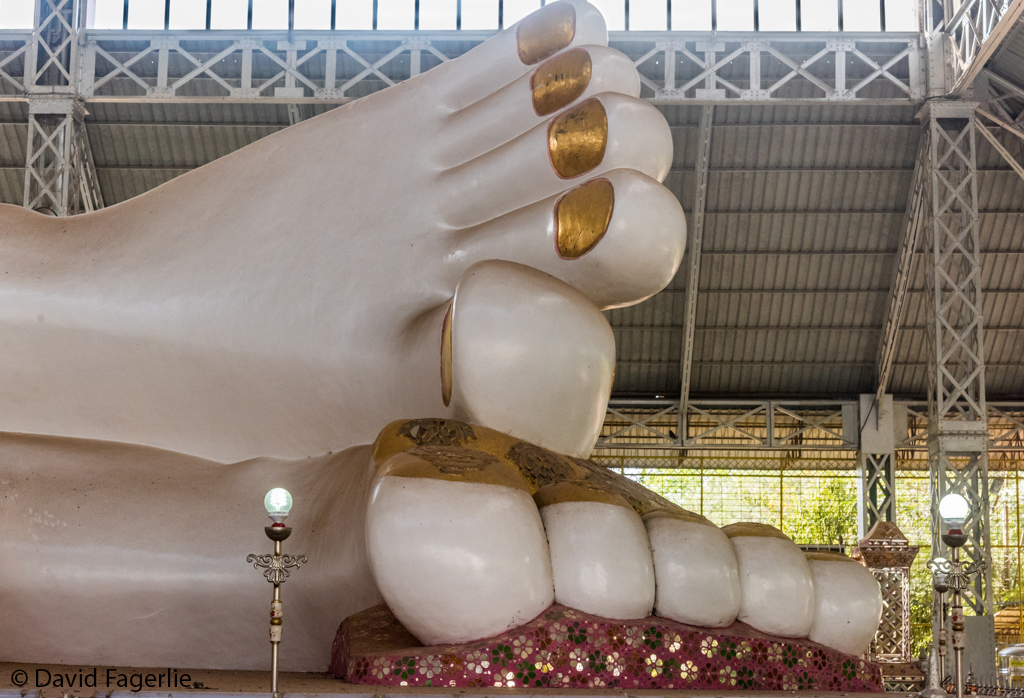
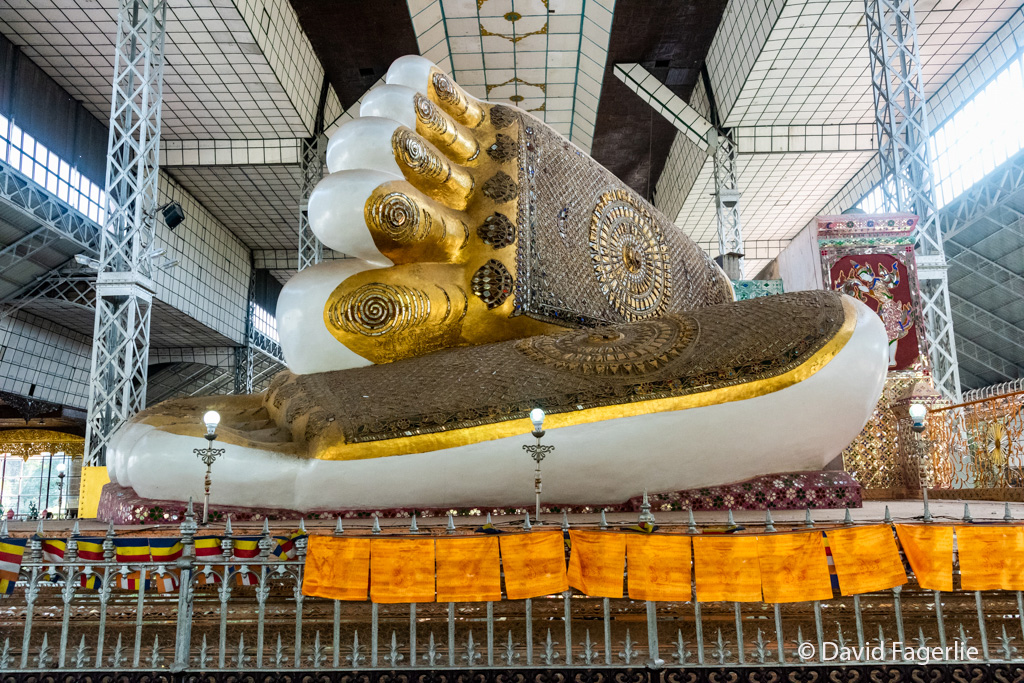
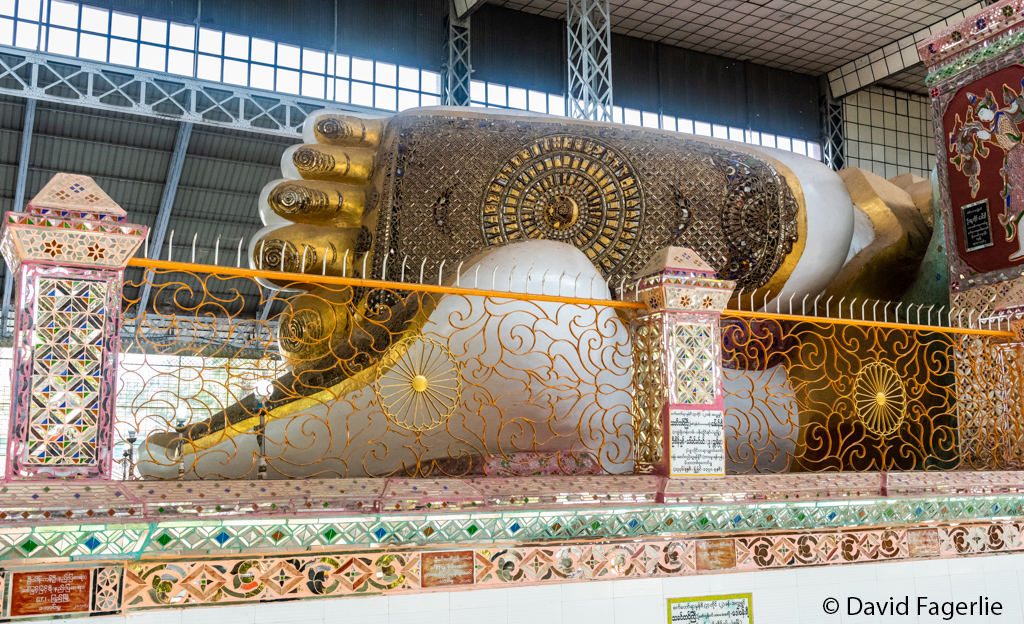
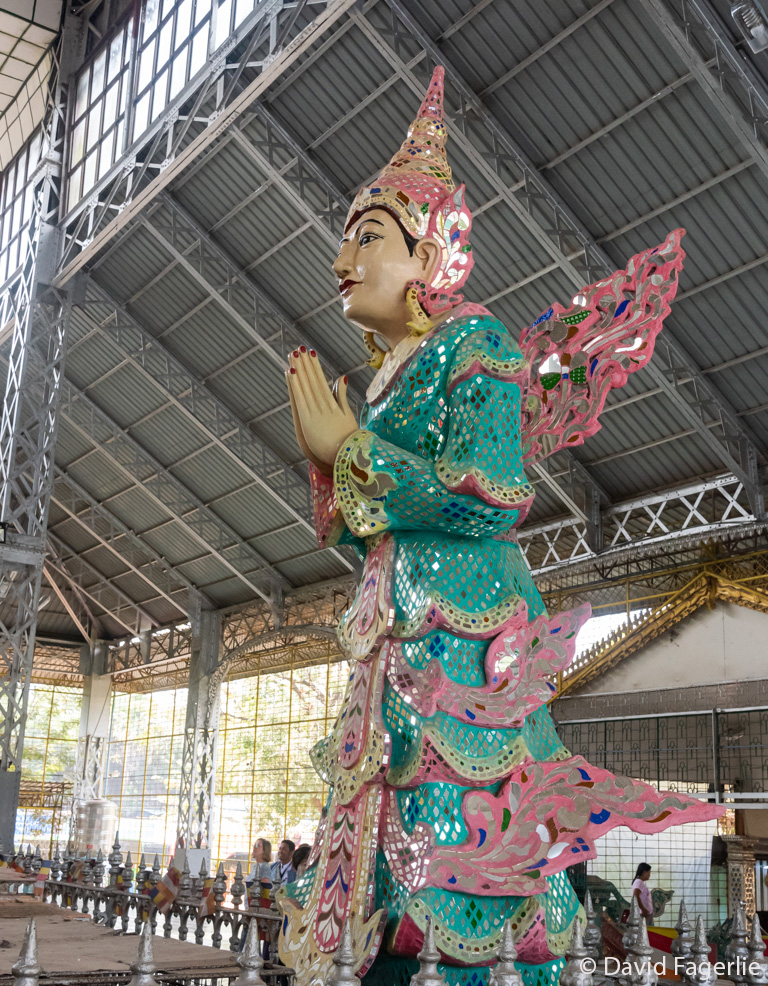
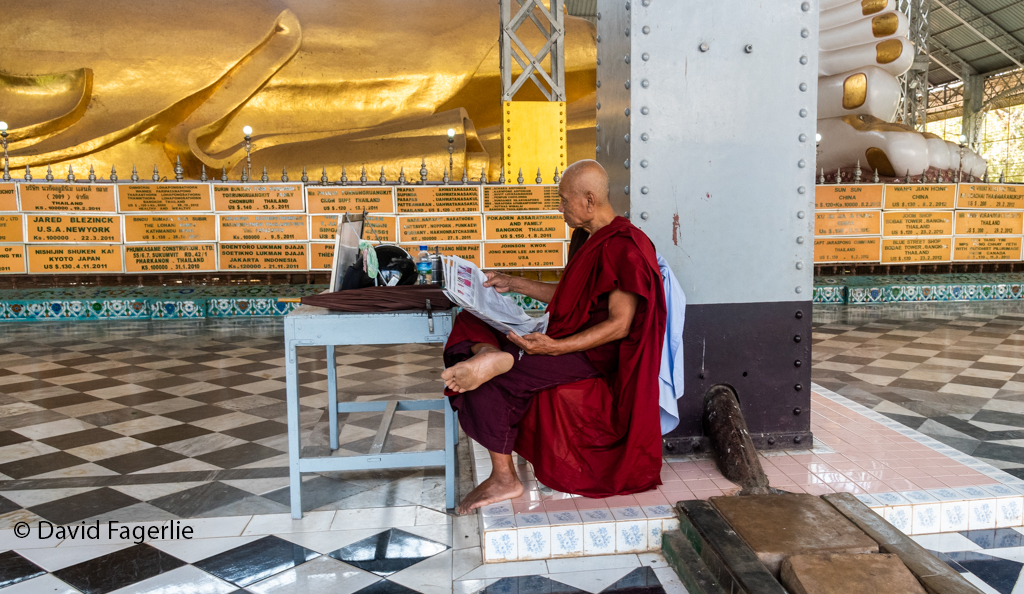
In a separate gallery on this website titled “Shwethalyaung Buddha Murals” I included photos of ten murals located behind the Buddha telling the legend of the reclining Buddha statue. You will see immediately limitations I faced because of the proximity of structural supports of the building. I had neither a wide-angle lens nor a ladder needed to center the murals in my photos. Nonetheless, the visual representation of the story is fun to see.
The story goes like this: “One day a Prince, the son of King Mingadeipka, ventured into a forest. In a small nearby village the Prince meets a Mon woman, who is a follower of the Buddha. The Prince marries the woman and takes her back to the King’s palace.
Once in the palace, the Mon woman does not bow to the heathen statues of the King, but to an image of the Buddha instead. Angered by this, the King orders the woman to be killed as a sacrifice to his Gods.
In front of the heathen statue worshipped by the King, the woman prays to the three jewels of Buddhism, namely the Buddha, the Buddhist teachings and the Buddhist community. Right this moment, the heathen statue of the King breaks into pieces. The King, stricken with fear, realizes he has been worshipping the wrong God and orders a large statue of the Buddha to be erected.” – Renown Travel
It was a short flight from Yangon to Bagan. We stayed in Bagan two nights. If I visit Bagan again I will stay longer.
King Anawrahta founded the Pagan Empire in 1044, which encompassed the city of Bagan. He is credited with introducing Theravada Buddhism to the region. From 1044 until 1287 Bagan was the capital of the empire and its political, economic and cultural center. Bagan’s rulers and their wealthy subjects constructed a plethora of religious monuments – approximately 1,000 stupas, 10,000 small temples and 3,000 monasteries, – all within an area of 104 square kilometers. Bagan became a center for religious and secular studies attracting monks and students from as far away as India and Sri Lanka. The culture was dominated by religion, primarily Theravada and Mahayana versions of Buddhism that coexisted.
The Pagan Empire collapsed in 1287 after repeated Mongol invasions beginning ten years earlier. Bagan was reduced from a thriving metropolis to a small town and ceased to be the capital of Burma in 1297. A small number of impressive monuments were constructed through the mid-15th century with fewer than 200 new constructions between the 15th and 20th centuries. Patronage of a small number of temples insured they were systematically renovated.
Over 400 earthquakes since 1904 and a huge quake in 1975 took a toll on the monuments. Many underwent restoration by a military government in the 1990s.
As a child I enjoyed the peacefulness of wandering in fields of tall grass at my grandparent’s farm. I strolled in a nearby field of tall grass in Bagan that offered me a similar feeling with one big difference. The fields in Bagan are populated with stupas, that are a thousand years old, every thirty feet or so. Extraordinary. Ancient stupas are in back yards, next to shops and restaurants, on the grounds of hotels and along roadsides. Basically, the stupas are everywhere.

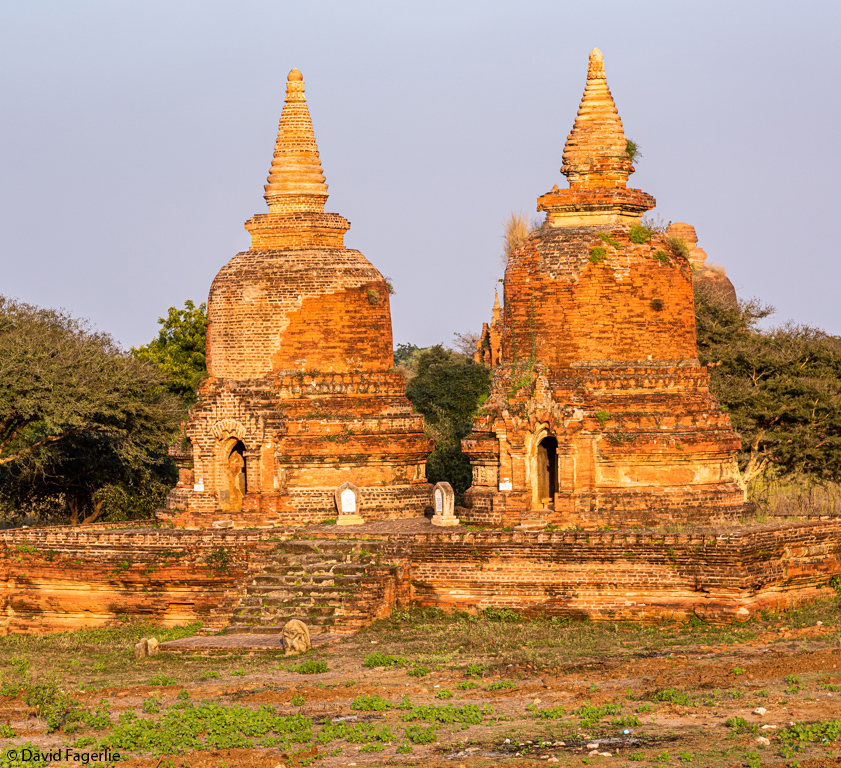
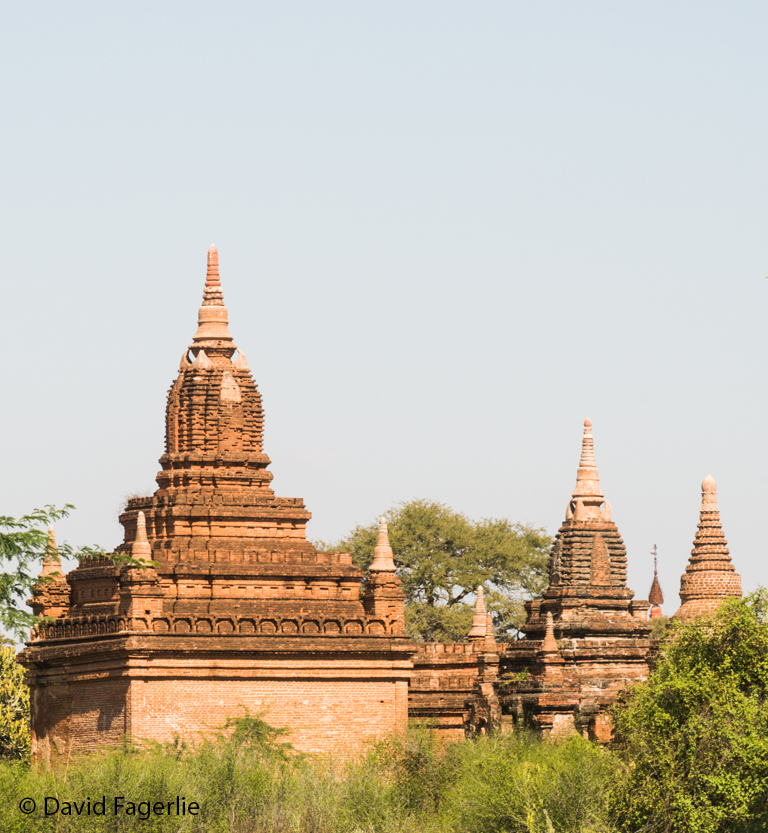
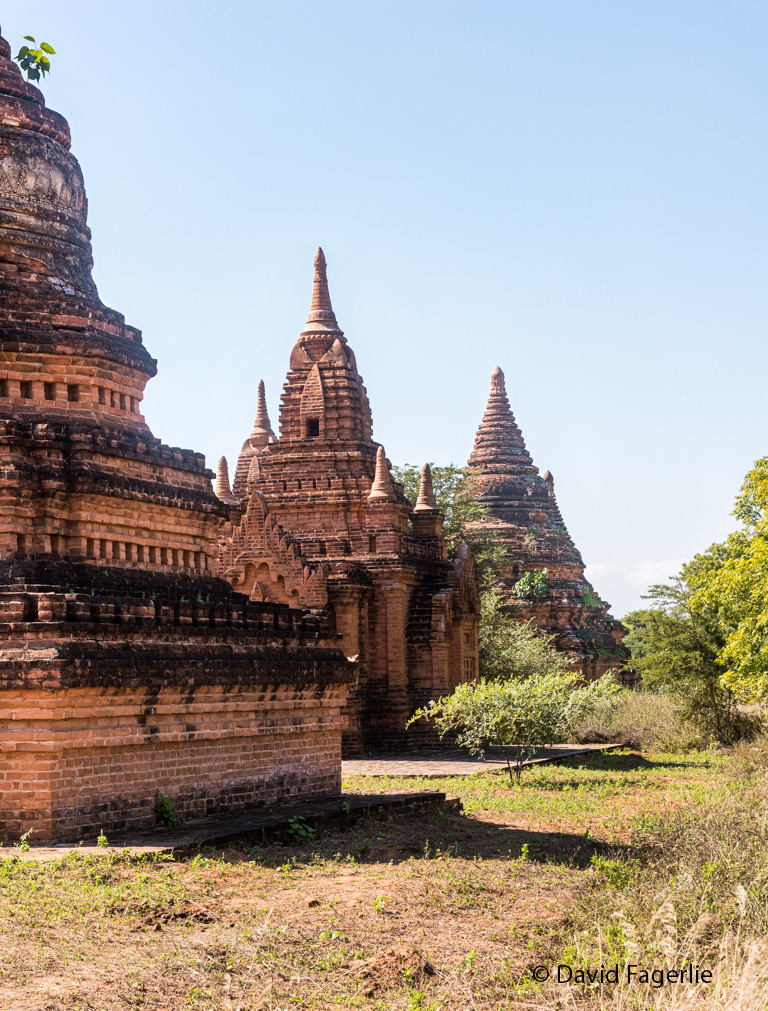
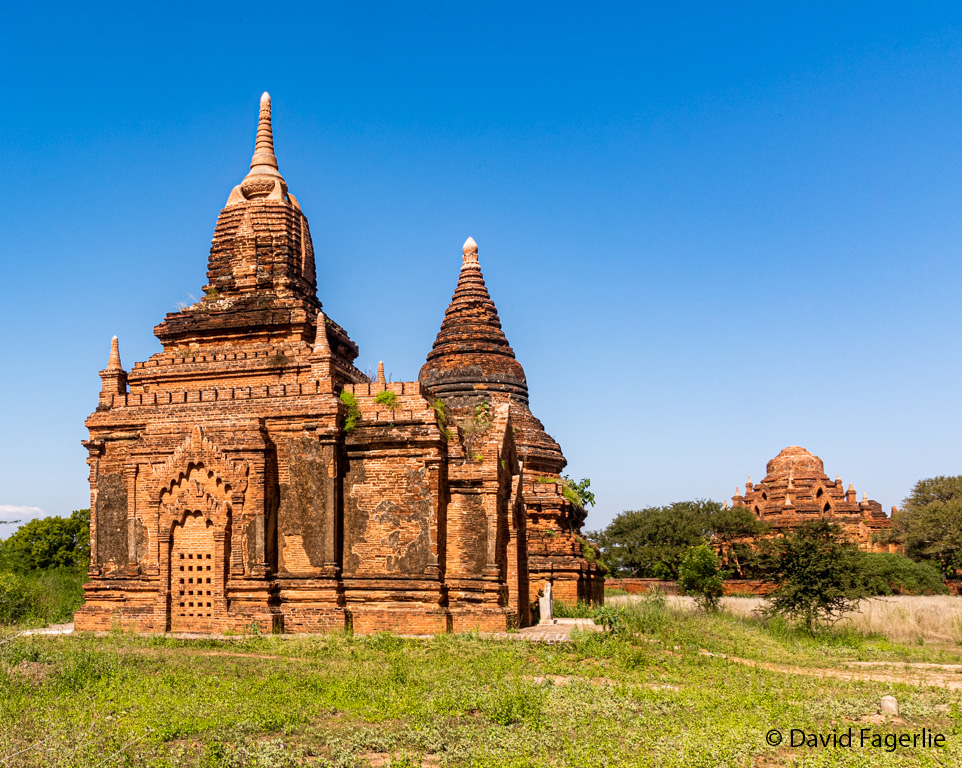
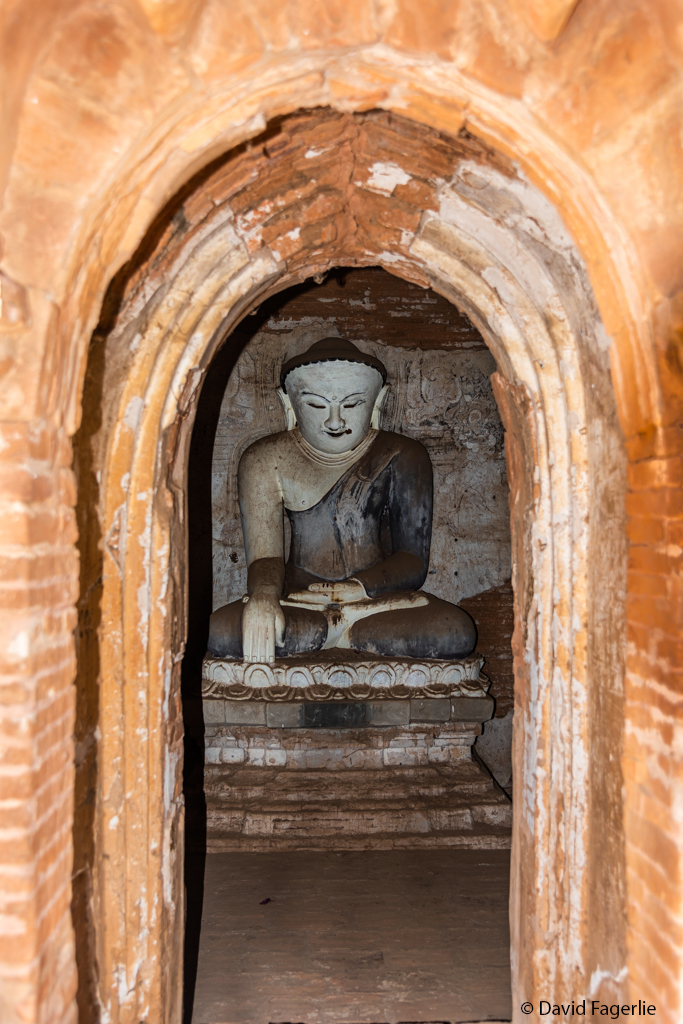
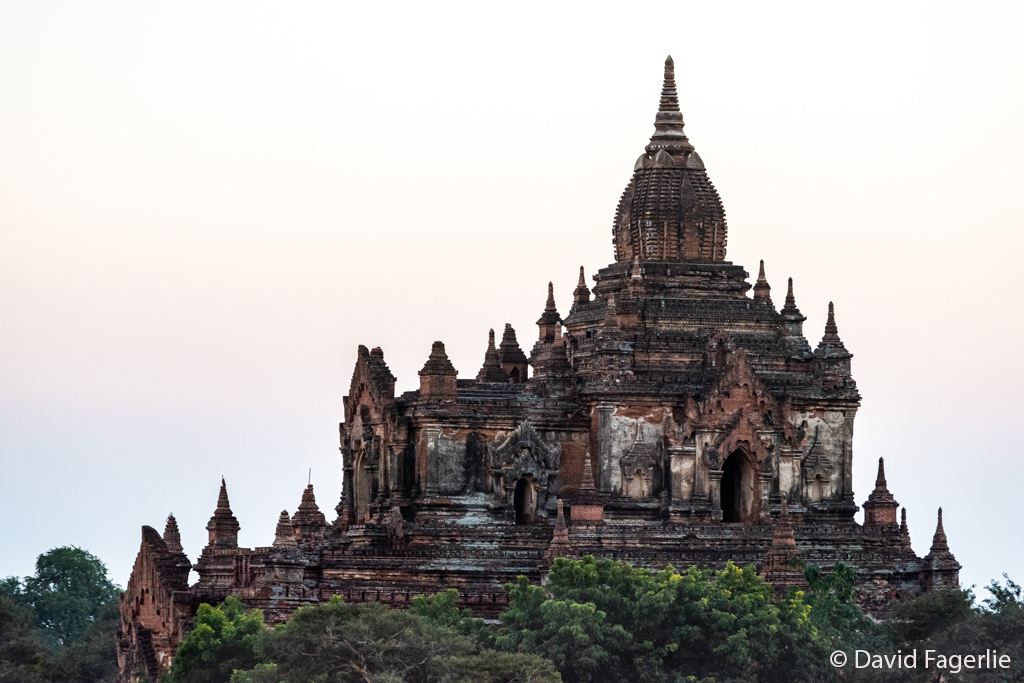
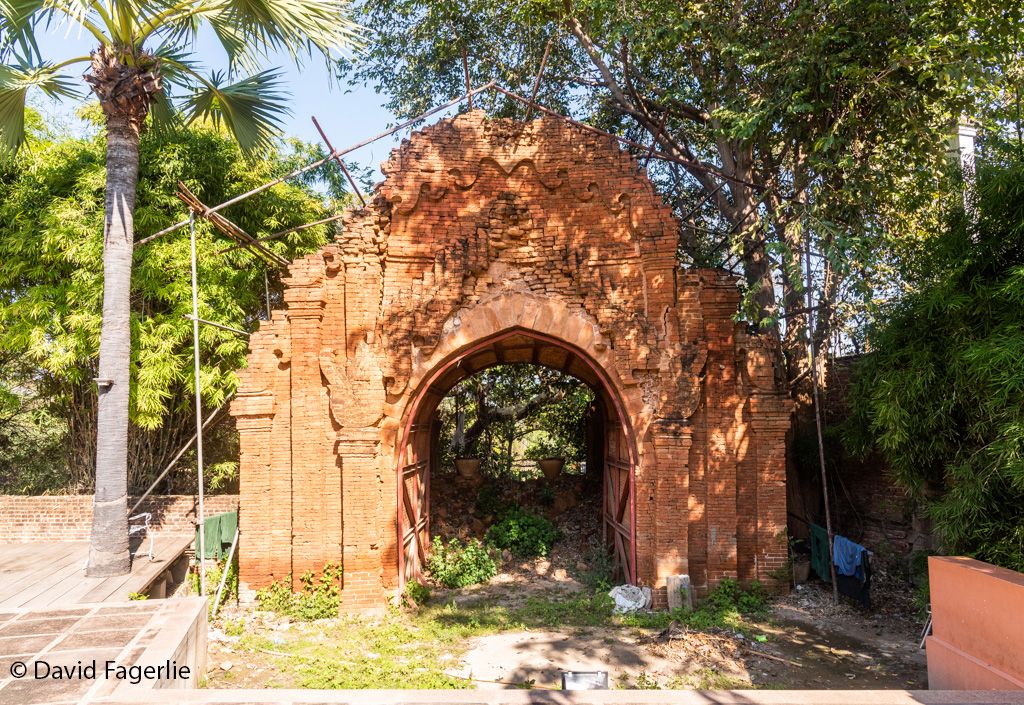
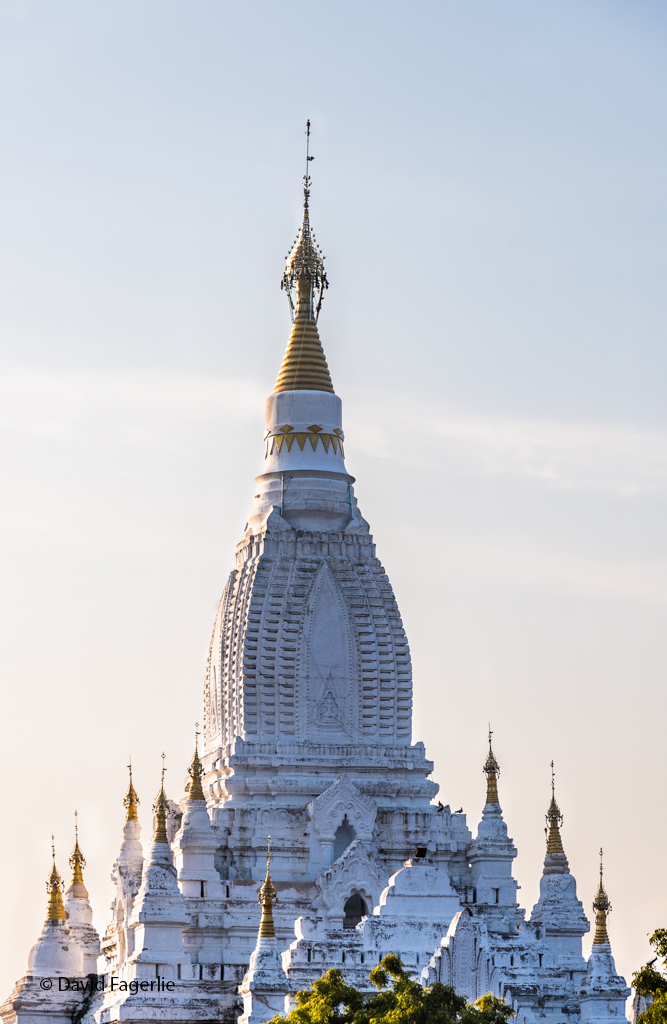
It was customary for wealthy families to erect stupas as they could afford them, not unlike how people today show their wealth by building big houses or naming buildings. Each generation would seek to keep the tradition going, building bigger and better stupas to impress the community and their family.
One of the most important stupas in all of Myanmar is the Shwezigone Pagoda in Bagan. Construction began during the reign of King Anawrahta and was completed in 1102 during the reign of his son, King Kyansittha, making it one of the oldest of the really spectacular pagodas. It is believed that the pagoda contains a bone and tooth of the Gautama Buddha brought from the city of Kandy in Sri Lanka, as well as the Buddha’s footprints.
“According to legend, Anawrahta selected the site for building this pagoda by sending a white elephant mounted with a frontal bone relic of the Buddha to roam freely with the declaration that wherever the elephant stopped would be the site for building the pagoda. The elephant finally stopped over a dune which was chosen as the site for erecting the pagoda, and hence the name Shwezigon pagoda meaning "golden pagoda on a dune" in Burmese.” – SK, Lim 2011. Asia Civilizations: Ancient to 1800 AD
One of the reasons this pagoda is so important is that the design was trendsetting. It has been copied many times throughout Myanmar over the centuries. The pagoda was gold leaf gilded. In recent renovations after earthquake damage it was covered with 30,000 copper plates. The stupa has a solid core. It is about 49 meters high and the sides of the square platform holding the stupa are also 49 meters long.
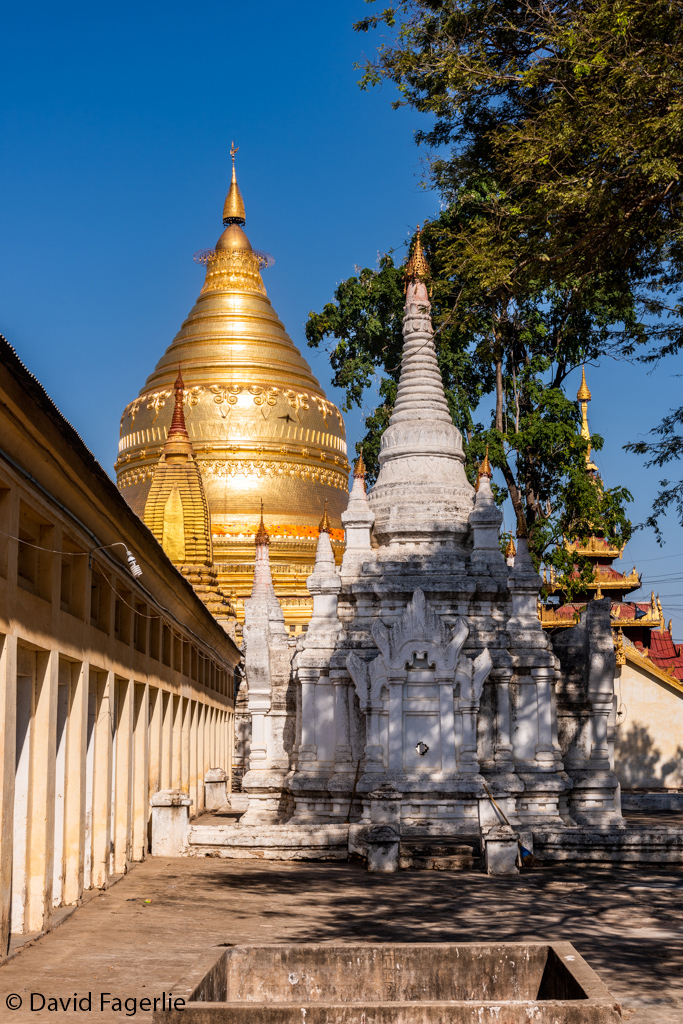
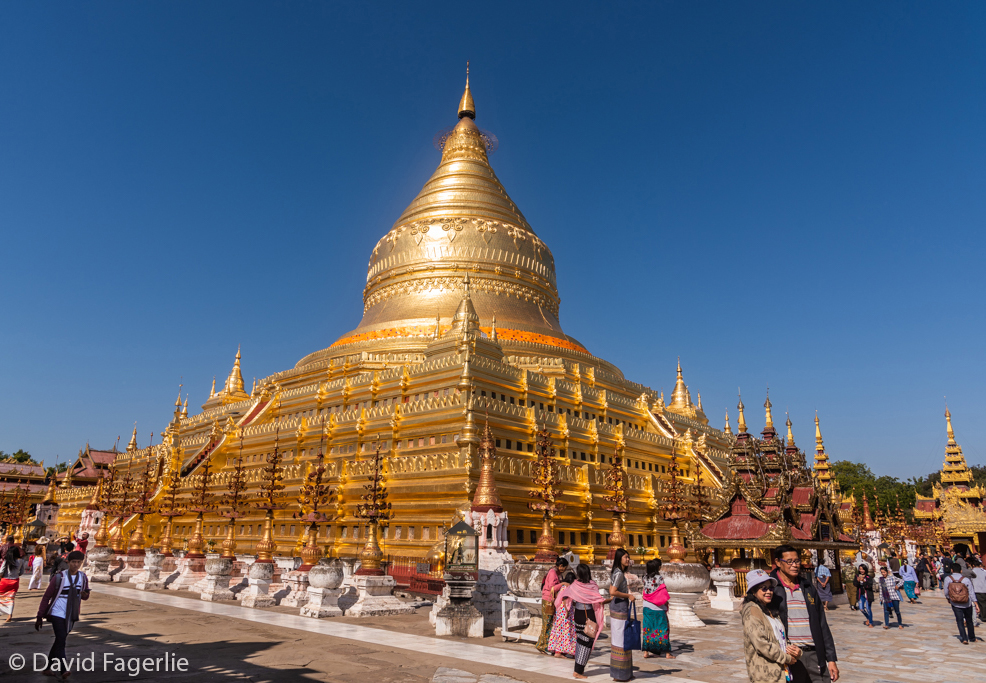
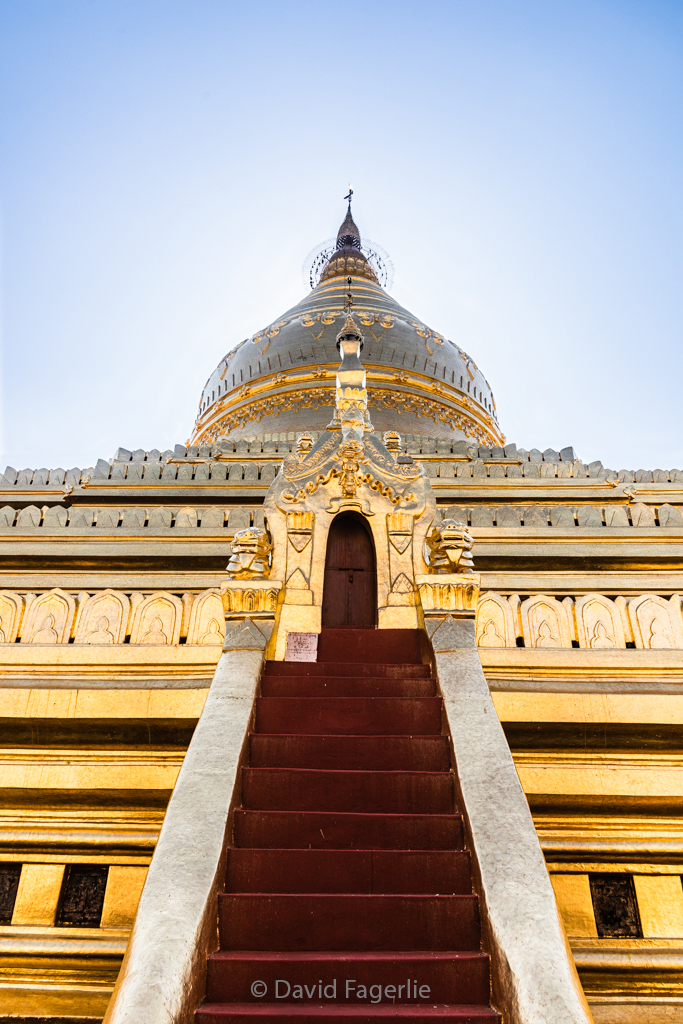
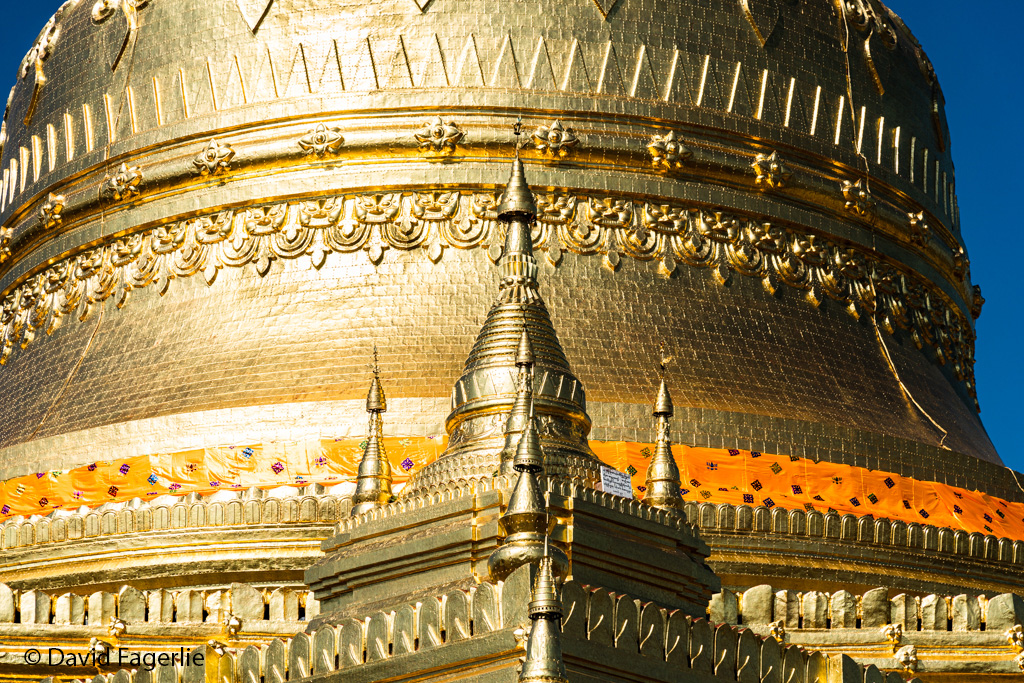
“Nats,” figurines that people before and during Anawrahta’s reign believed had deity powers, were commonly worshiped. It was believed that when people die they could become nats. Anawrahta allowed nats on the temple grounds as a political consideration. Nat figurines are available for purchase. I took these photos of nats at a manufacturing plant in Mandalay.
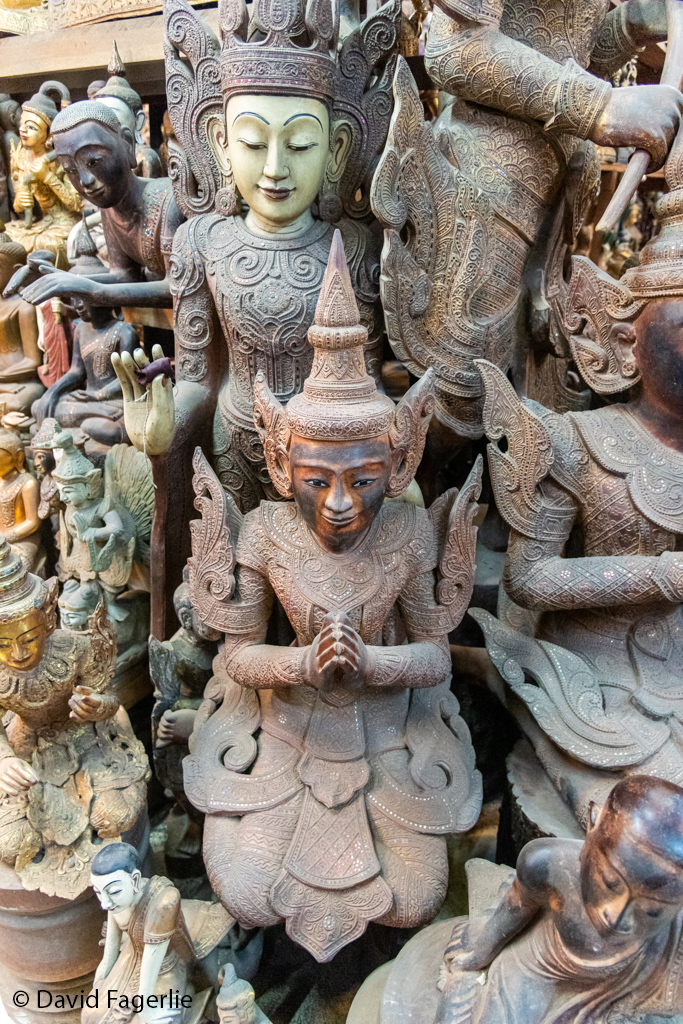
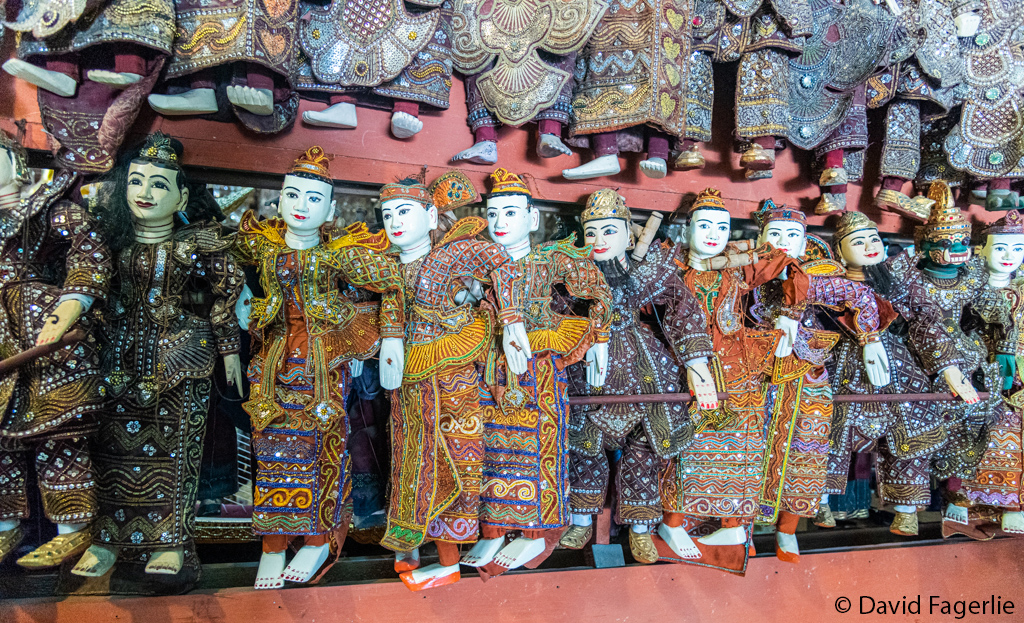
There is one place on the otherwise mostly solid structure where a plant grows, bringing life to the stupa. You may have noticed this design feature at the Shuemawdaw Paya in Bago as well?
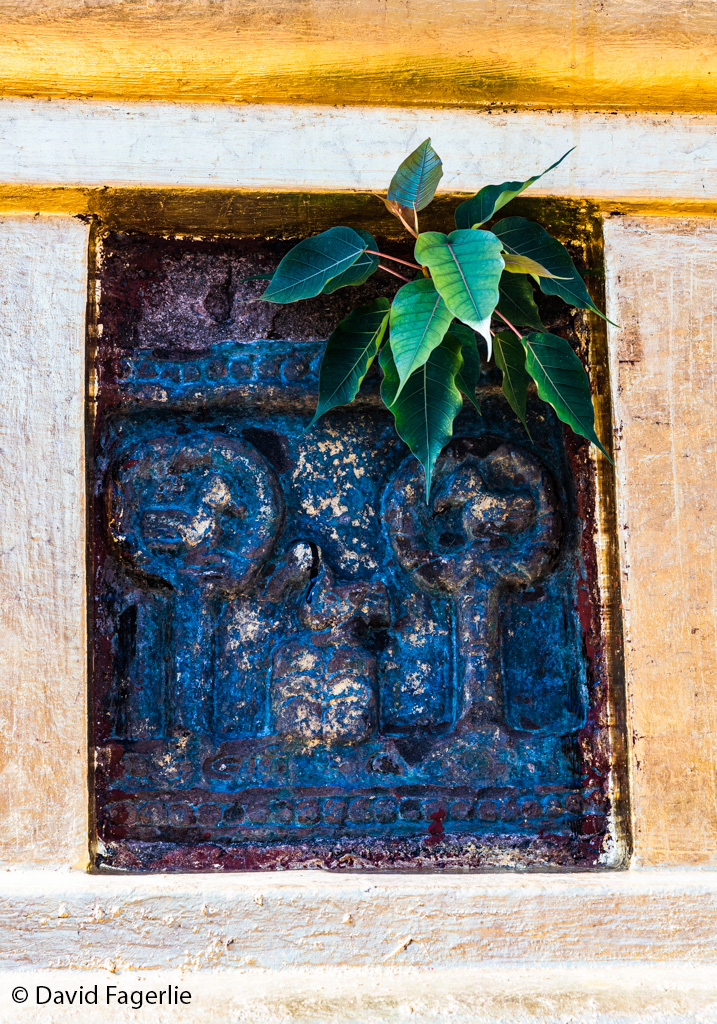
Around the pagoda are terraces and buildings containing a variety of items including wooden carvings.

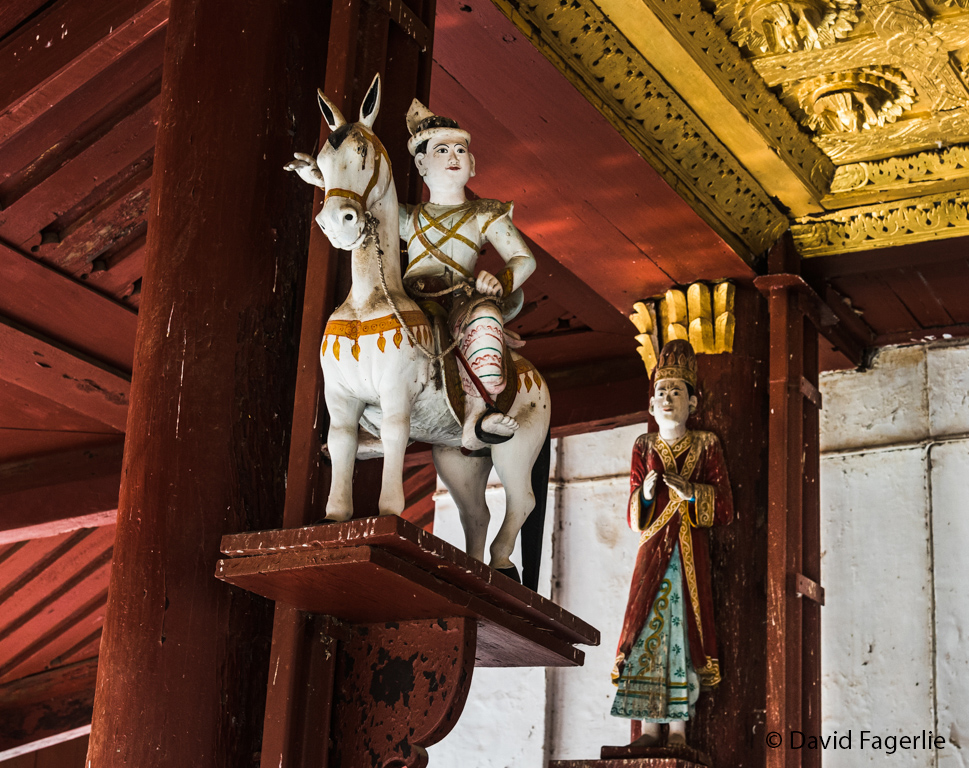
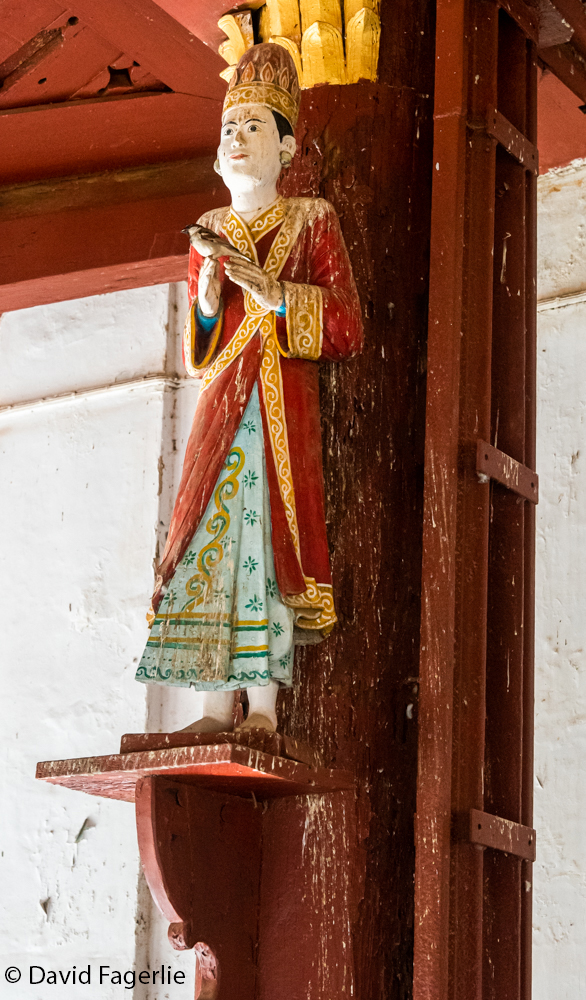
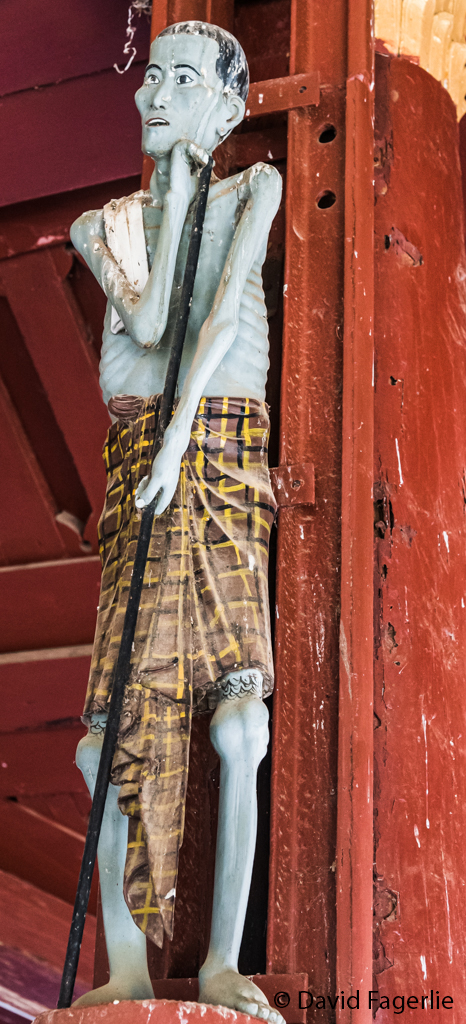
Htilominlo was king of the Pagan dynasty from 1211 until his death in 1235. During his reign the empire began its decline, the effect of over a century of tax-free religious wealth that reduced the empire’s potential tax base.
King Htilominlo completed construction of the Htilominlo Temple in 1218 CE. It is a massive three-story temple made of red brick. The temple is set on a platform that is of equal length on each side except for the Eastern entry that is larger and extends further out from the center. On the inside the brick was plastered with white stucco, some of which remains.
My photos convey the temple’s style and interior. To appreciate its magnitude see aerial photos available on the internet. This was my favorite temple in Bagan for the feeling I got from being inside. Only the first floor was open to visitors; but, that was enough. I especially enjoyed the tunnel like hallways with arched ceilings that led to beautiful Buddha images. I felt like I was in an Indiana Jones movie.
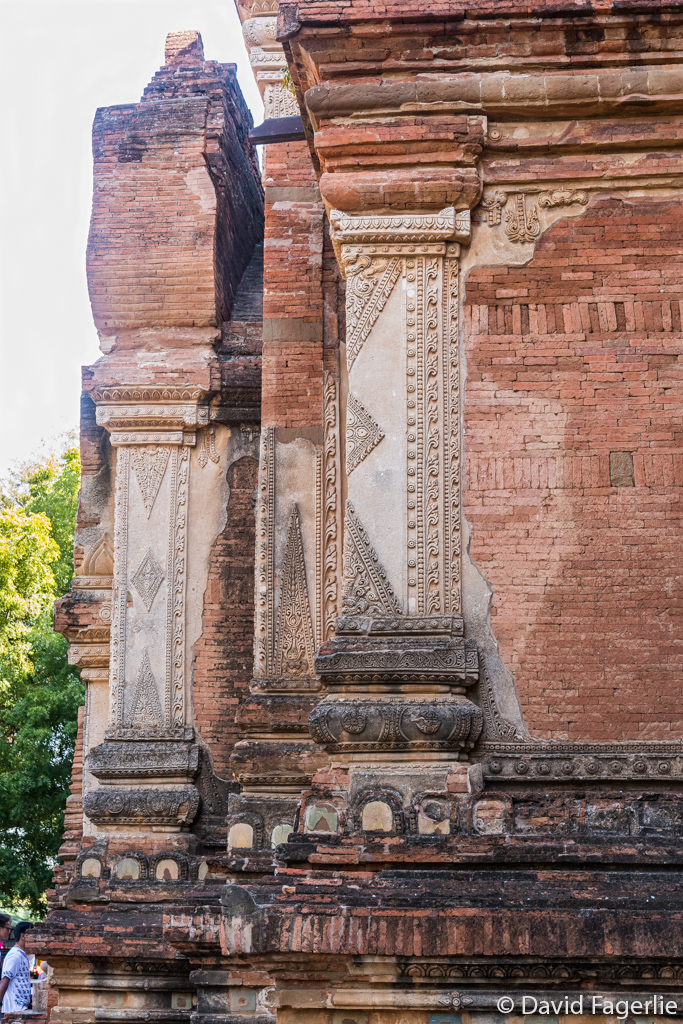
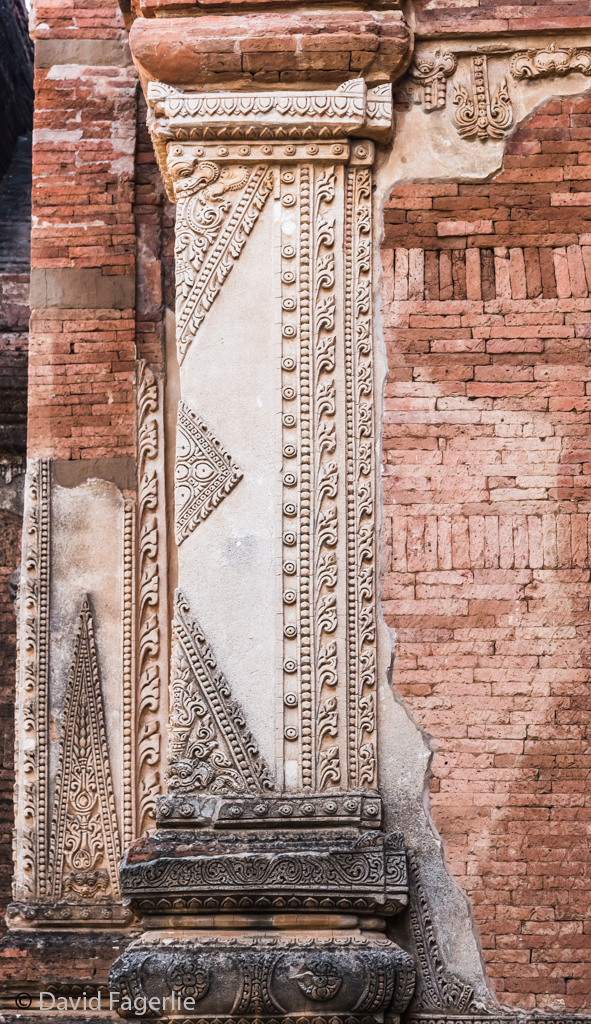
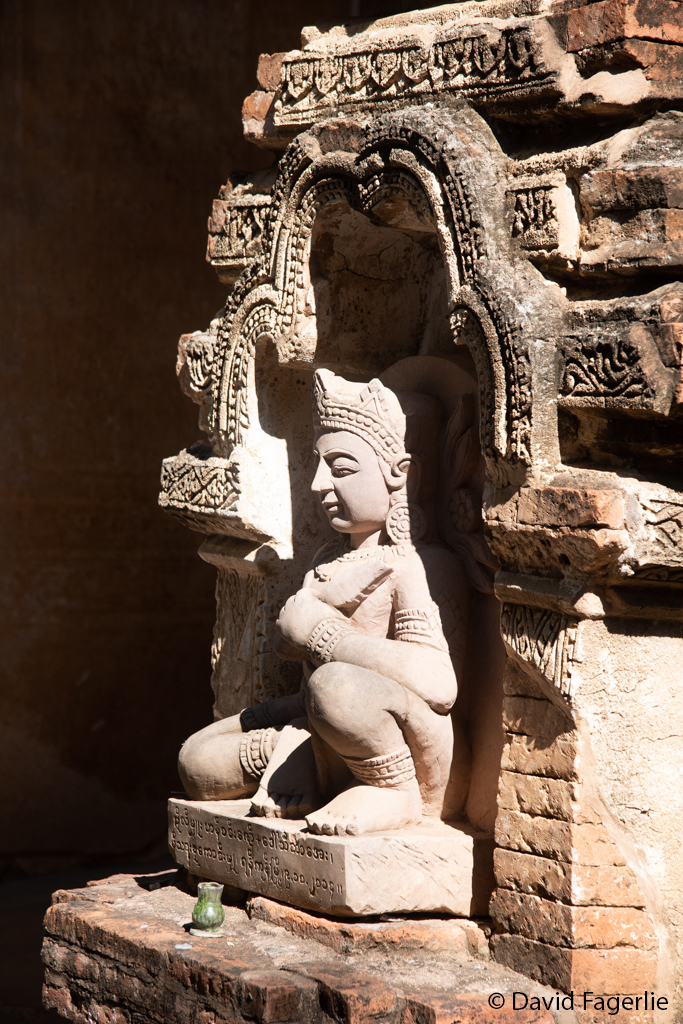
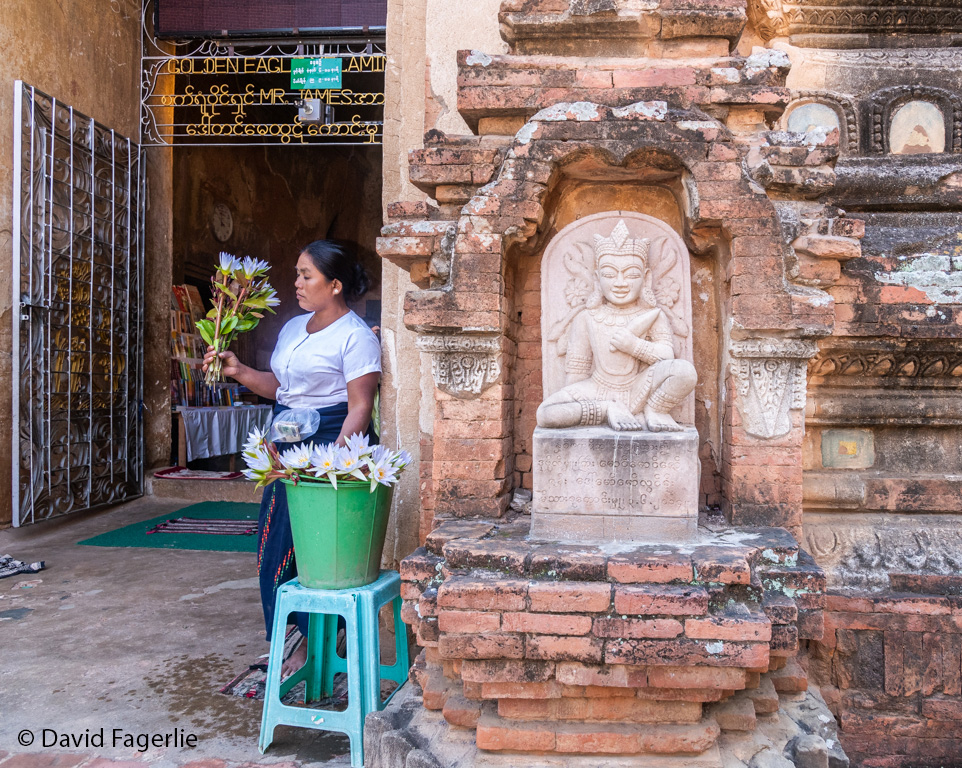
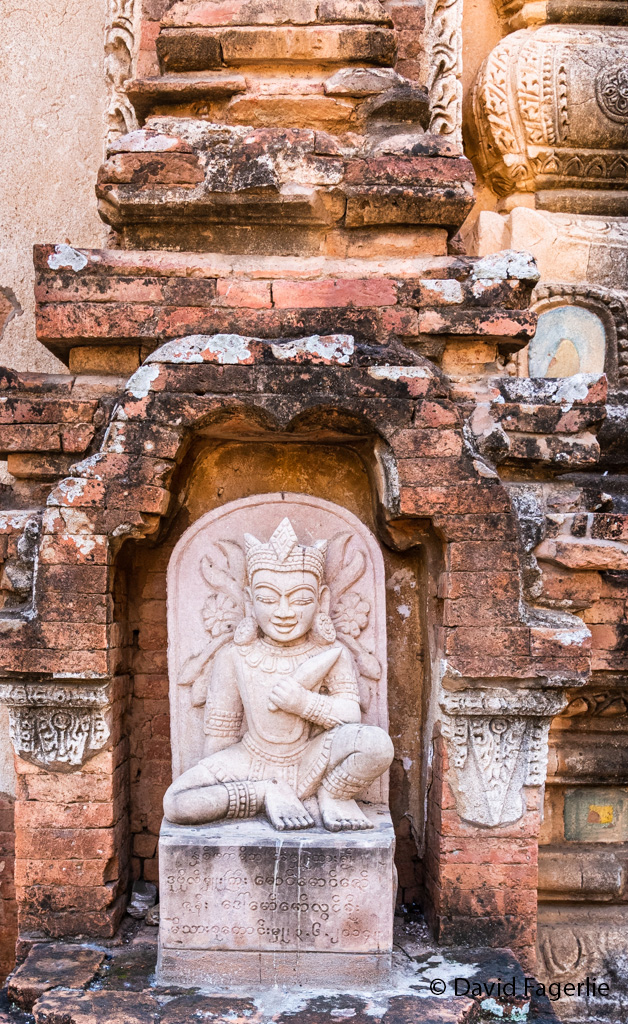
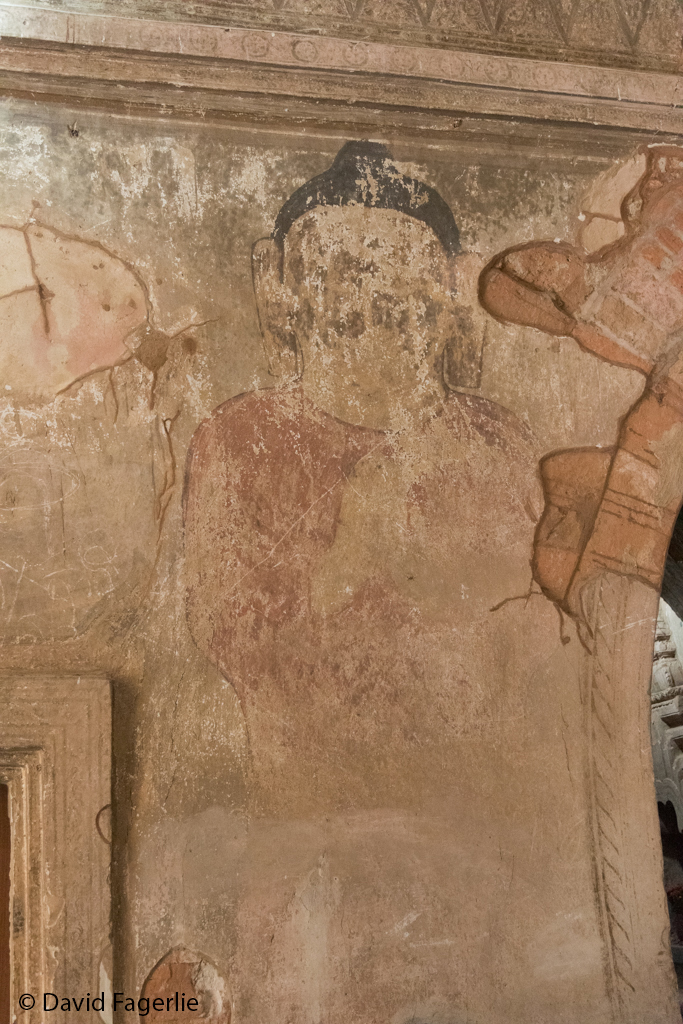
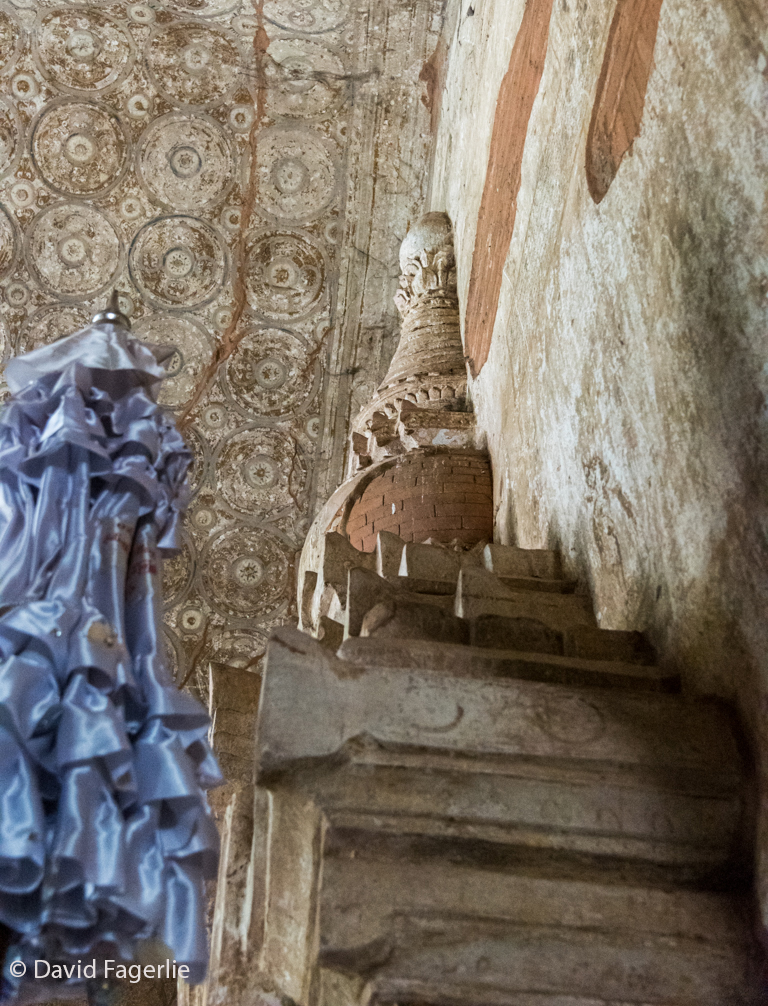
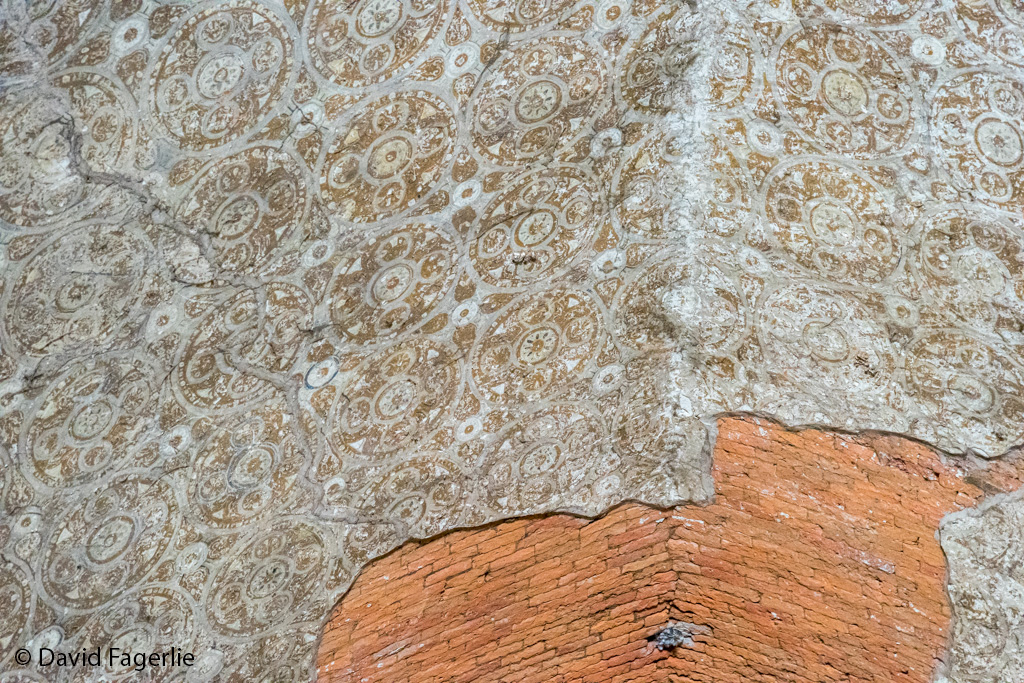
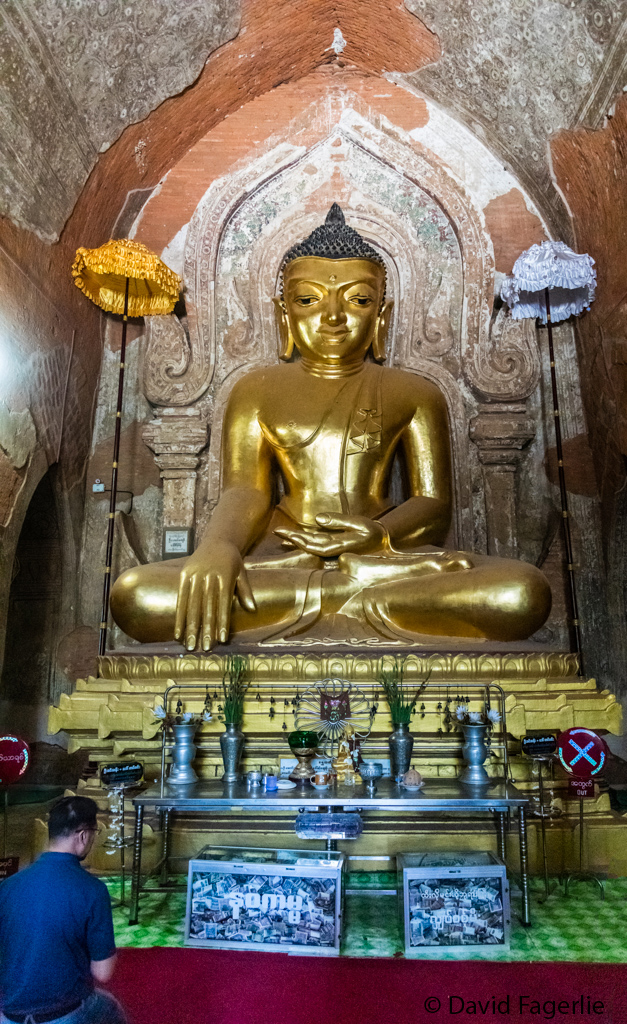
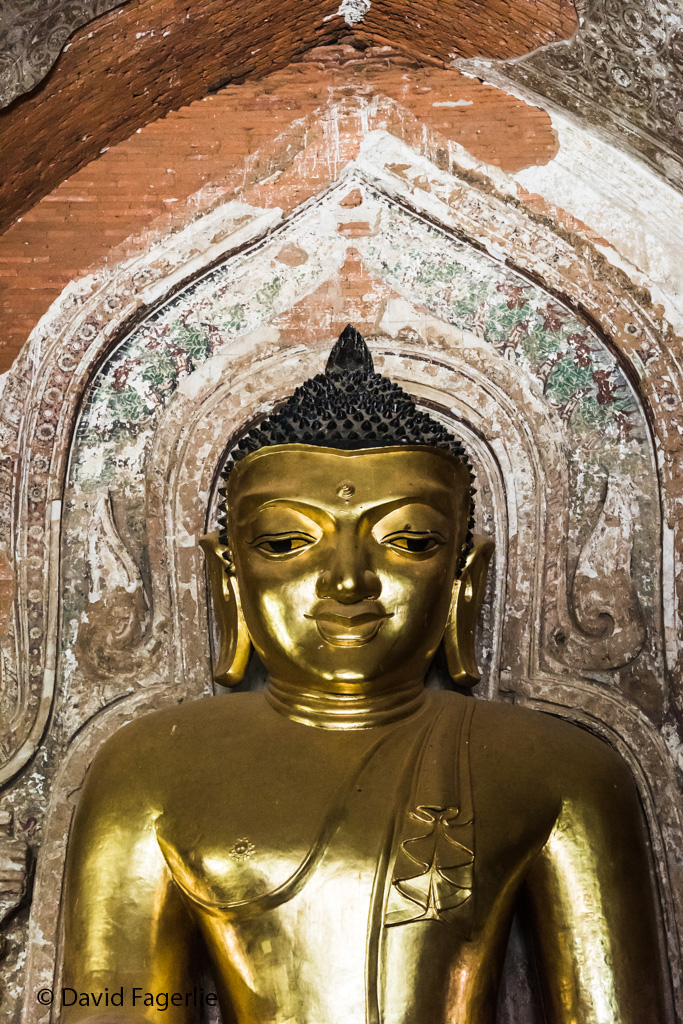
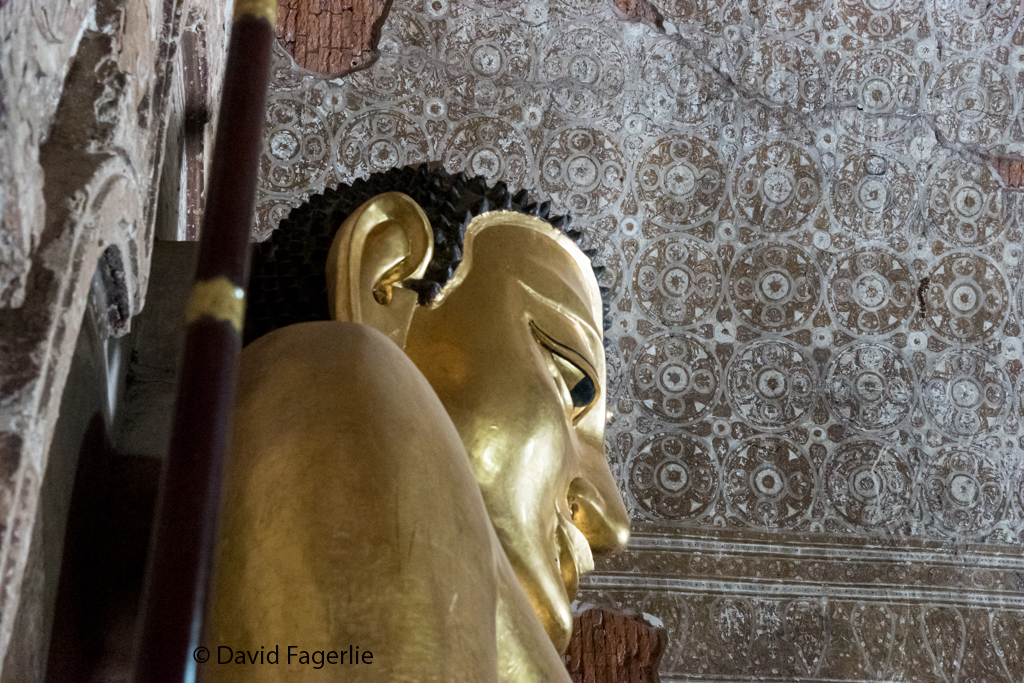
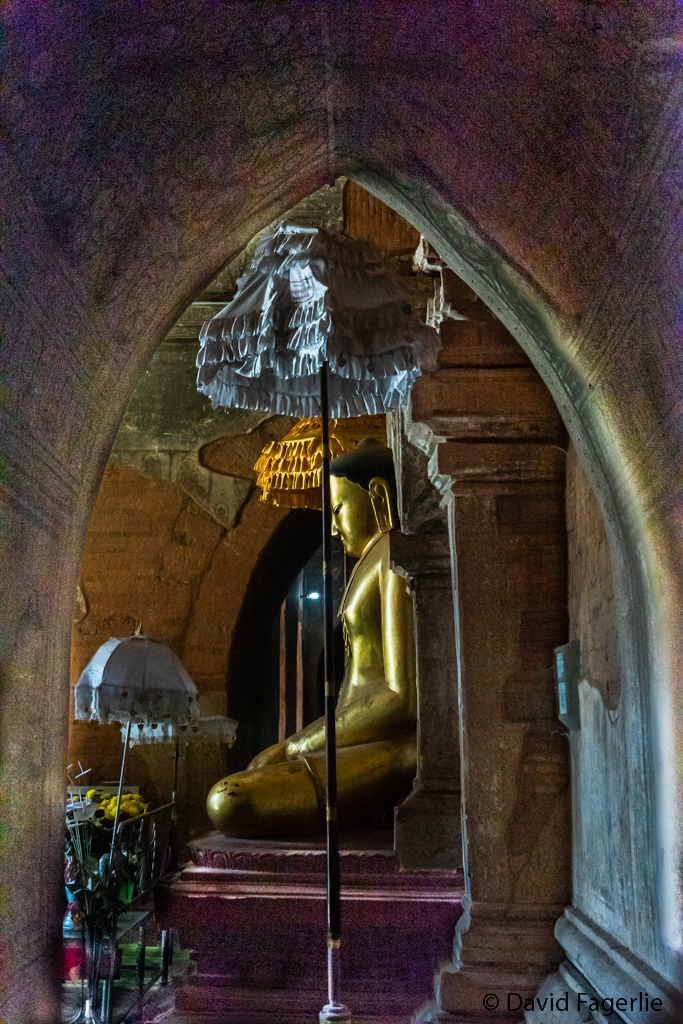
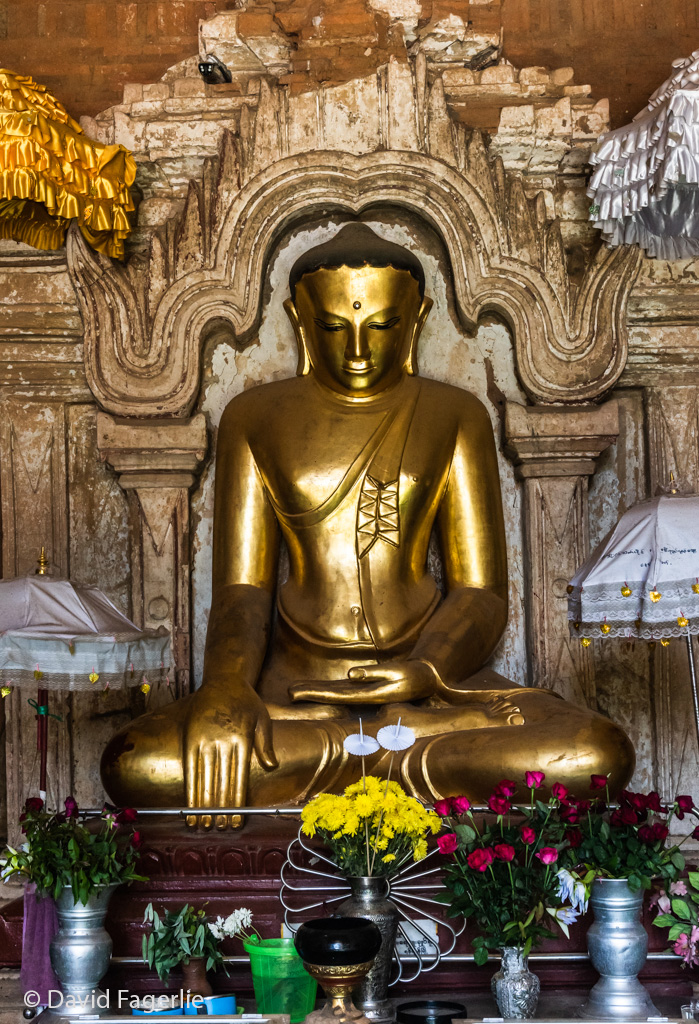
Ananda was the name of the Buddha’s first cousin. Ananda Temple was built by King Kyanzittha, son of King Anawrahta. The temple was a manifestation of Kyanzittha’s desire to carry forward his father’s support for Theravada Buddhism. Construction was completed in 1105 CE. Legend states that eight monks who approached King Kyanzittha seeking alms gave a graphic description of the Nandamula Cave temple in the Himalayas where they had meditated. The king invited them to the palace so he could hear more details. King Kyanzittha, pleased with this show of their skills, requested the monks to build a temple in the middle of the Bagan plains. In order to retain the uniqueness of the temple, after the monks completed the temple construction, he had the monks killed to ensure that another similar structure was not built by them anywhere else.
Critics seem to agree that the Ananda Temple is the most beautiful temple in Bagan; I certainly thought so. Seeing it up close was one thrill; seeing it from a distance was another.
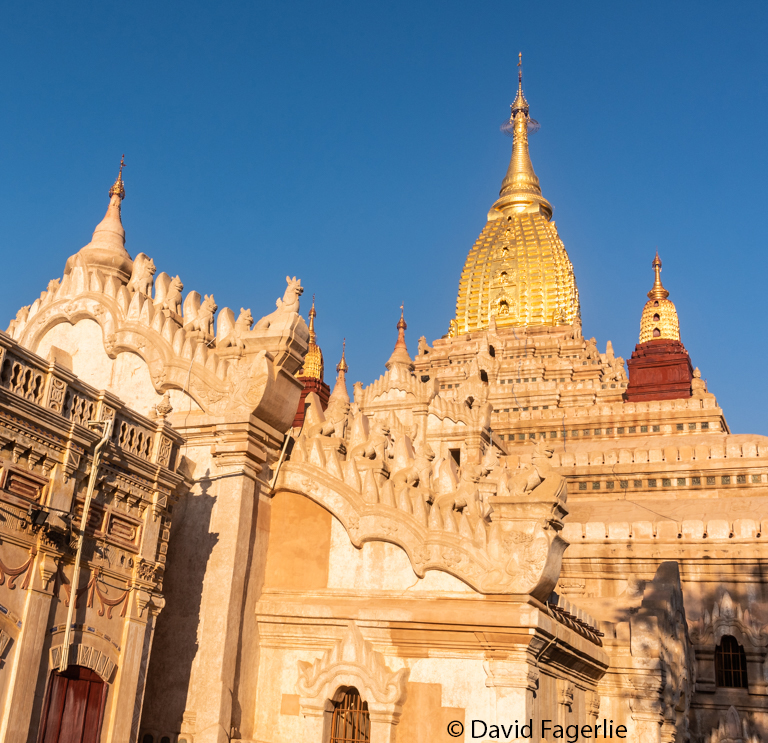
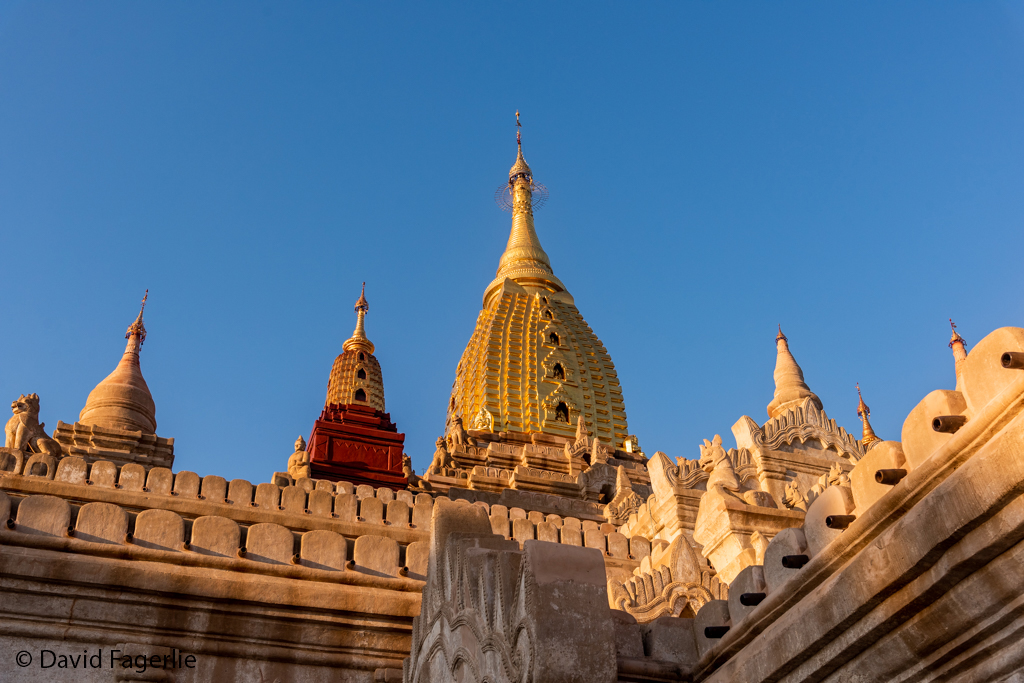
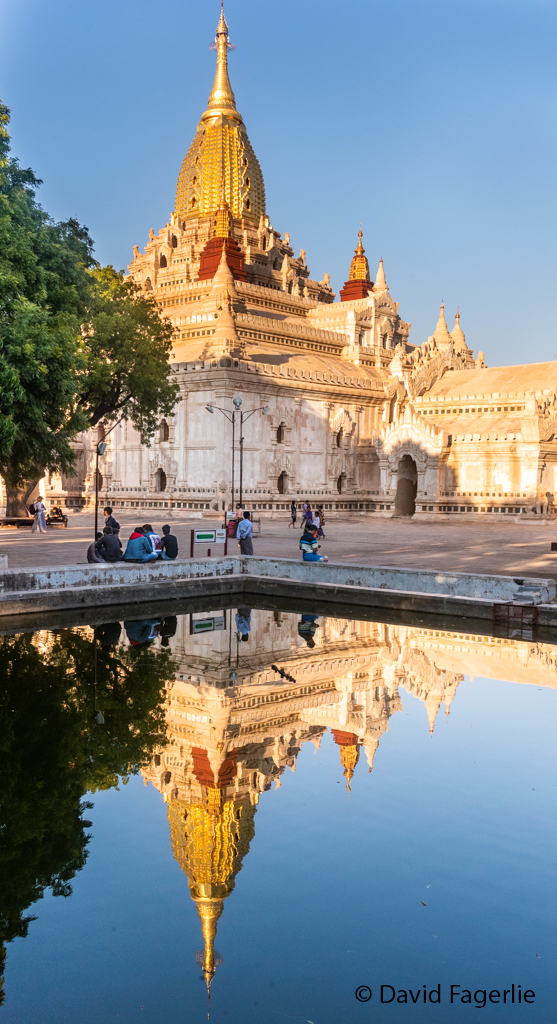
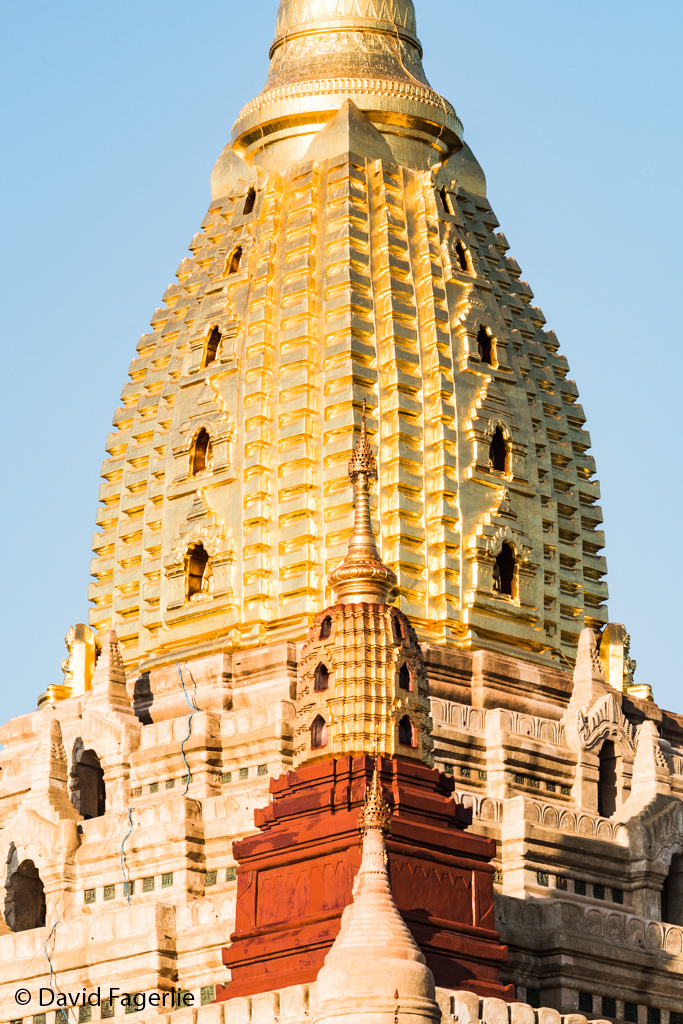
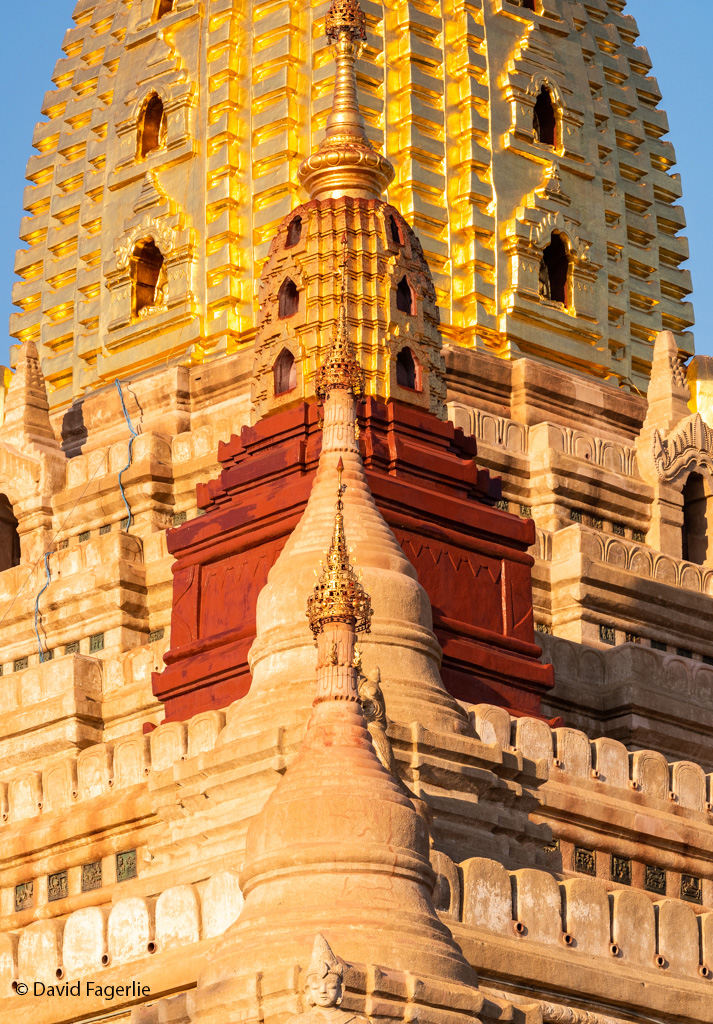
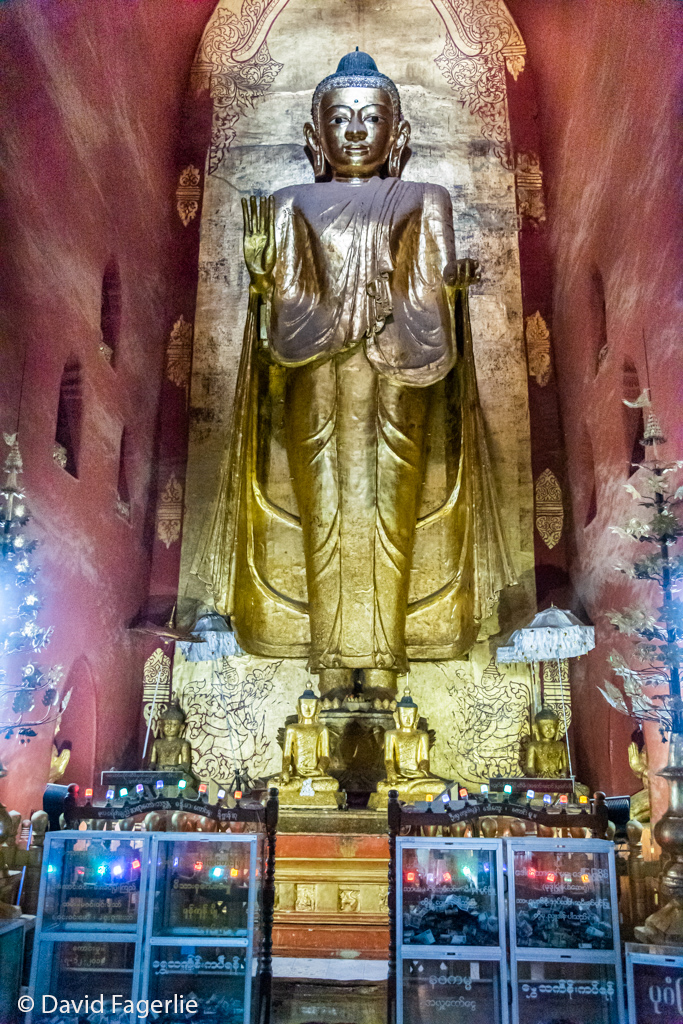
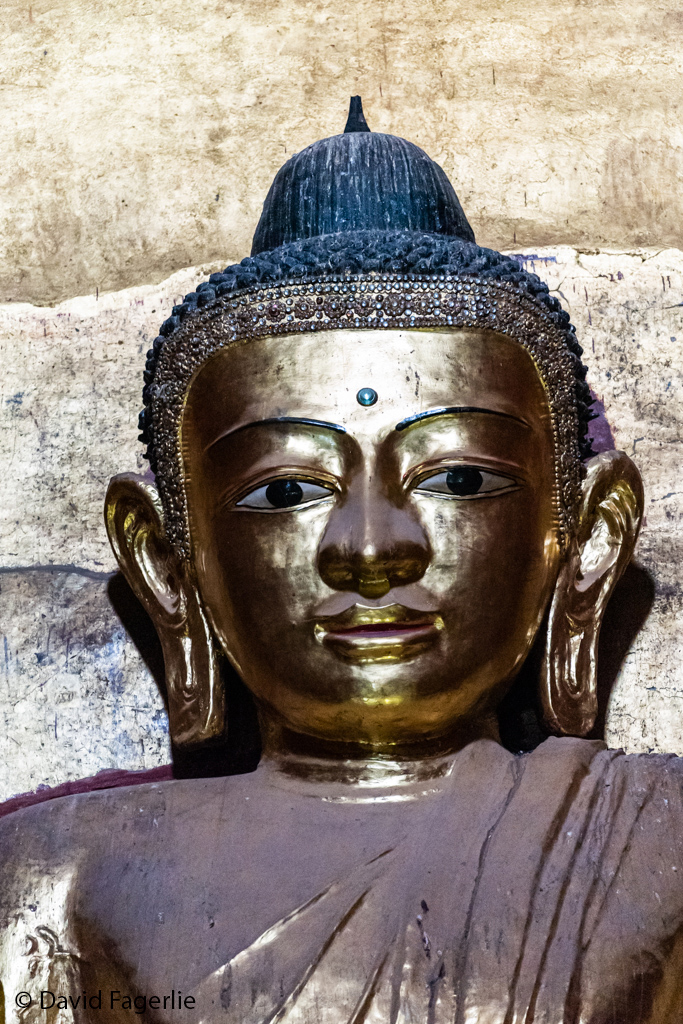
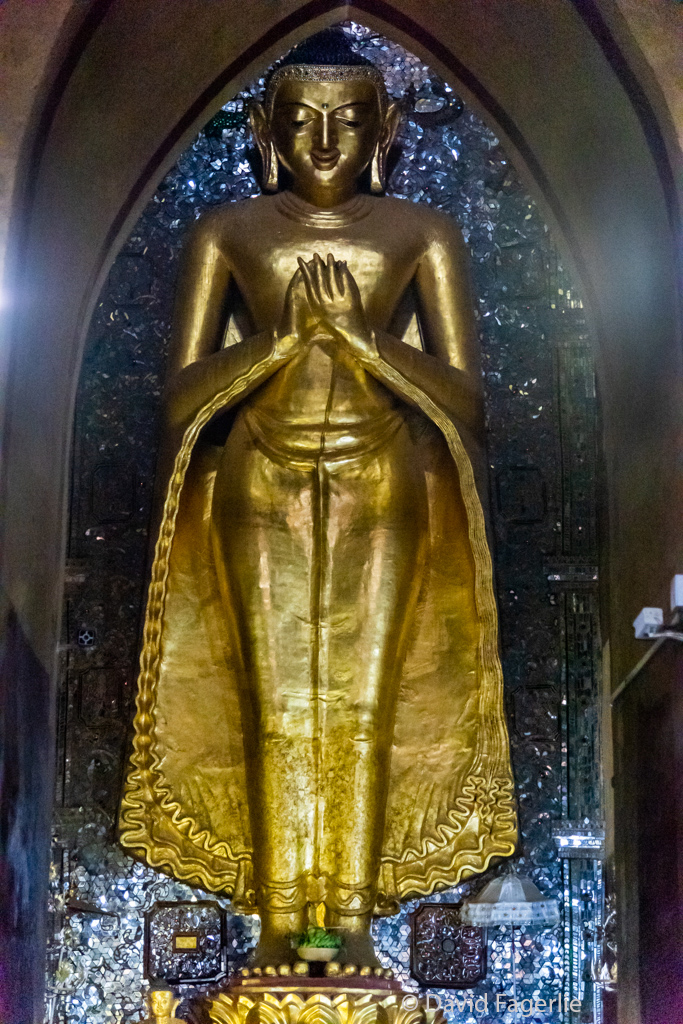
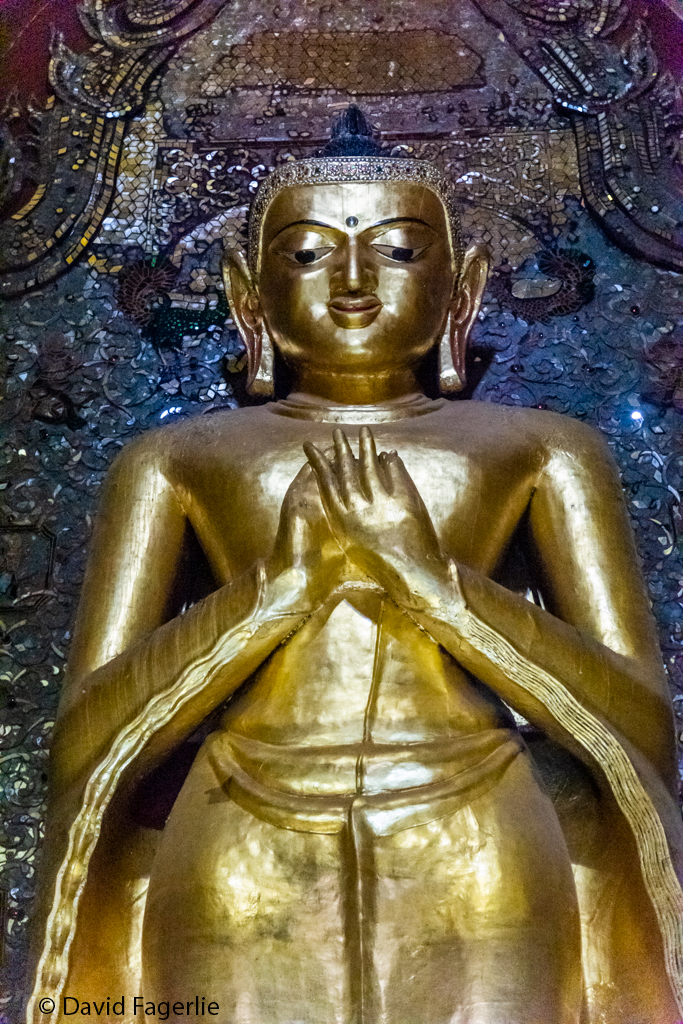
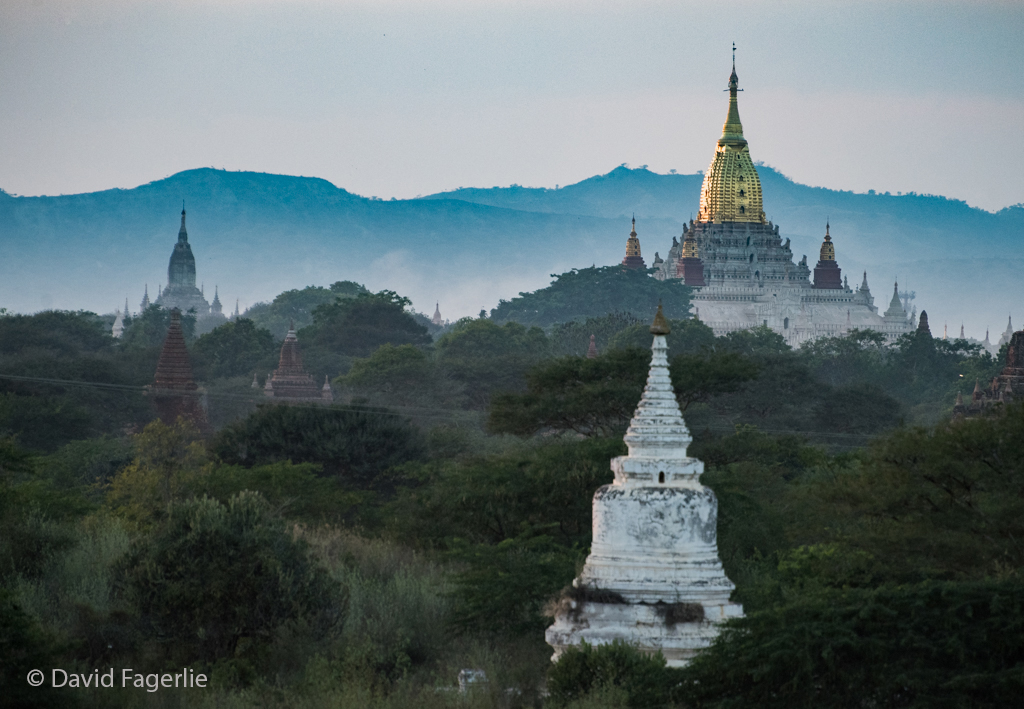

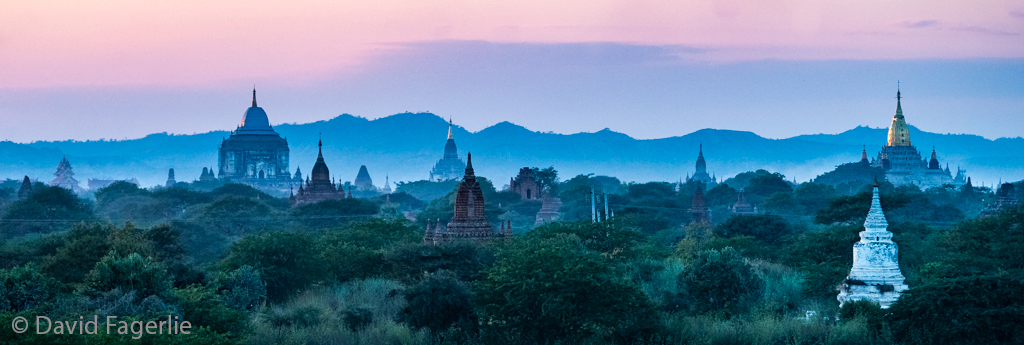
Mount Popa is an extinct volcano about 50 kilometers from Bagan. The name Popa is derived from the Sanskrit word “puppha,” meaning “flower.” Medicinal plants are in abundance on the volcano. Southwest of Popa is Taung Kalat (pedestal hill), a volcanic plug that was created when Popa was erupting. It is believed that Popa and Taung Kalat erupted during a terrible earthquake in 442 BCE. Legend claims that the nats from the kingdom of Tagaung sought refuge at Taung Kalat.
Taung Kalat was my destination. At the top of the volcanic plug is a Buddhist monastery. It is an important pilgrimage for Buddhists and there was an abundance of people when I visited. To get to the monastery required I climb 777 steps to the top of the volcanic plug. The number of steps did not give me pause and they were under cover of metal roofing, laid out in segments, providing protection from the sun; however, there were special circumstances of note. The monastery is a holy site. As such, neither shoes nor socks were allowed starting from the bottom of the plug. For a small contribution I checked my shoes and socks with a “protective service.” Protection was required to safeguard belongings from the hundreds of monkeys that have command of this destination. I was warned not to wear my glasses as they were a favorite item to be stolen by the monkeys. A crew of volunteers did a pretty good job of clearing the steps of monkey poop; alas, it still took some concentration on my part to dodge the excrement in my bare feet.
It was very hazy the day I was there. Photos I took from a restaurant terrace still convey the dynamics of the place. The experience of ascending to the monastery was well worth the 777 steps.
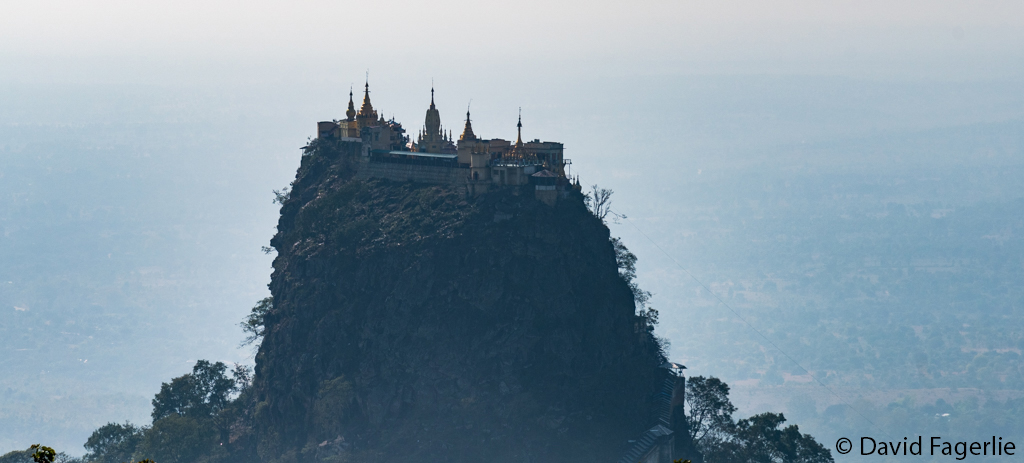
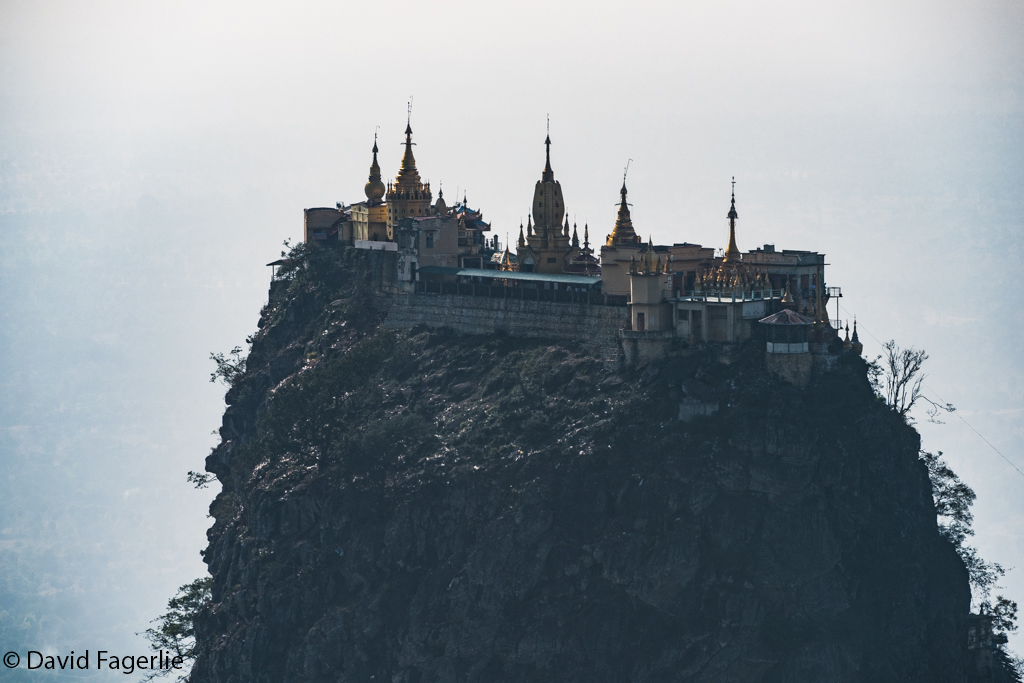
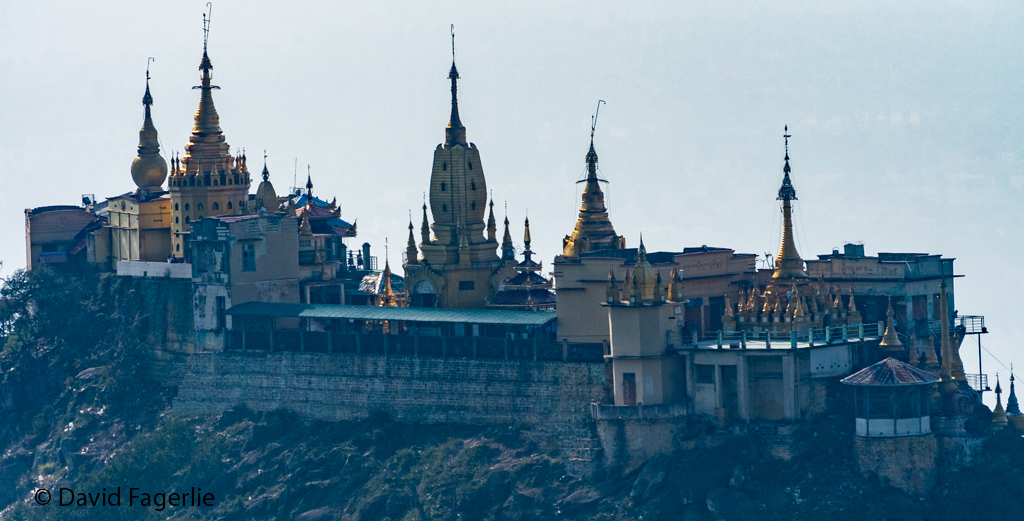
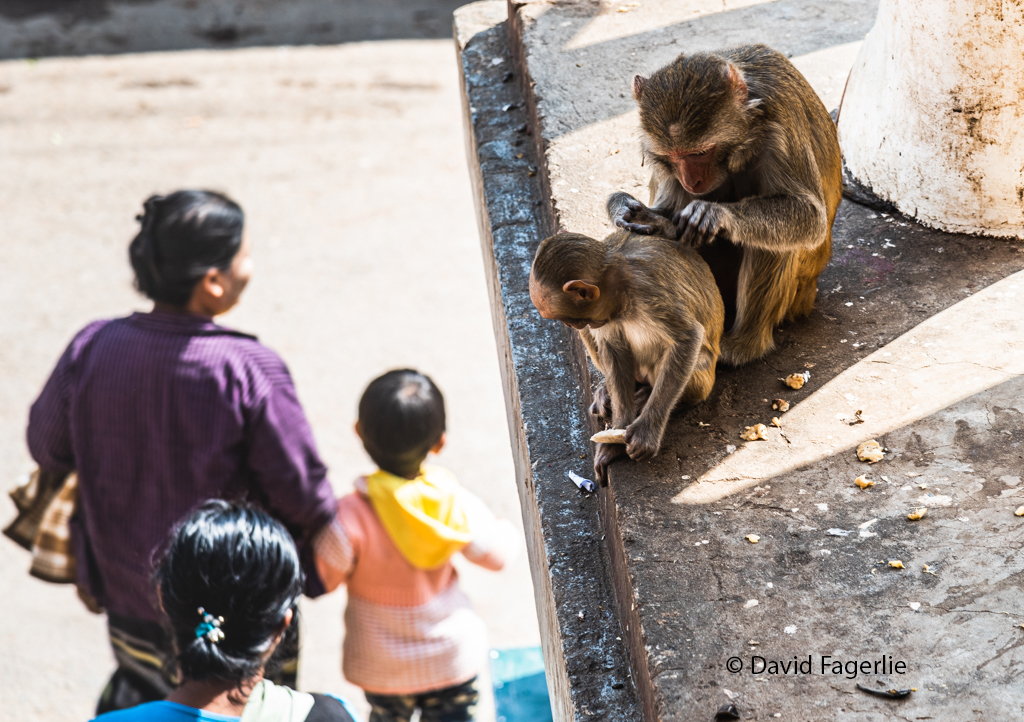

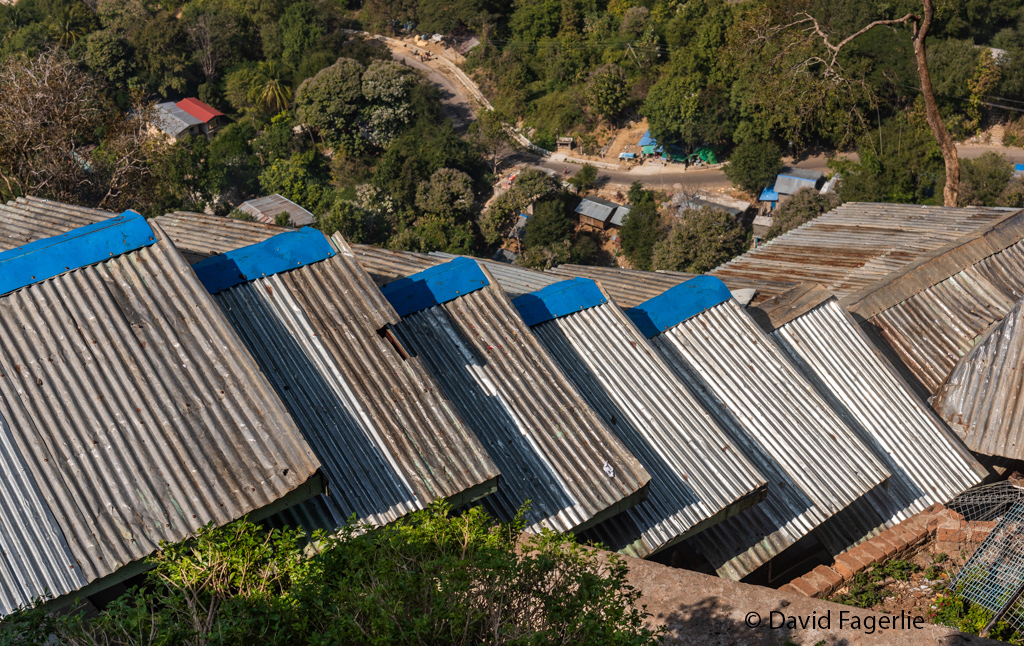
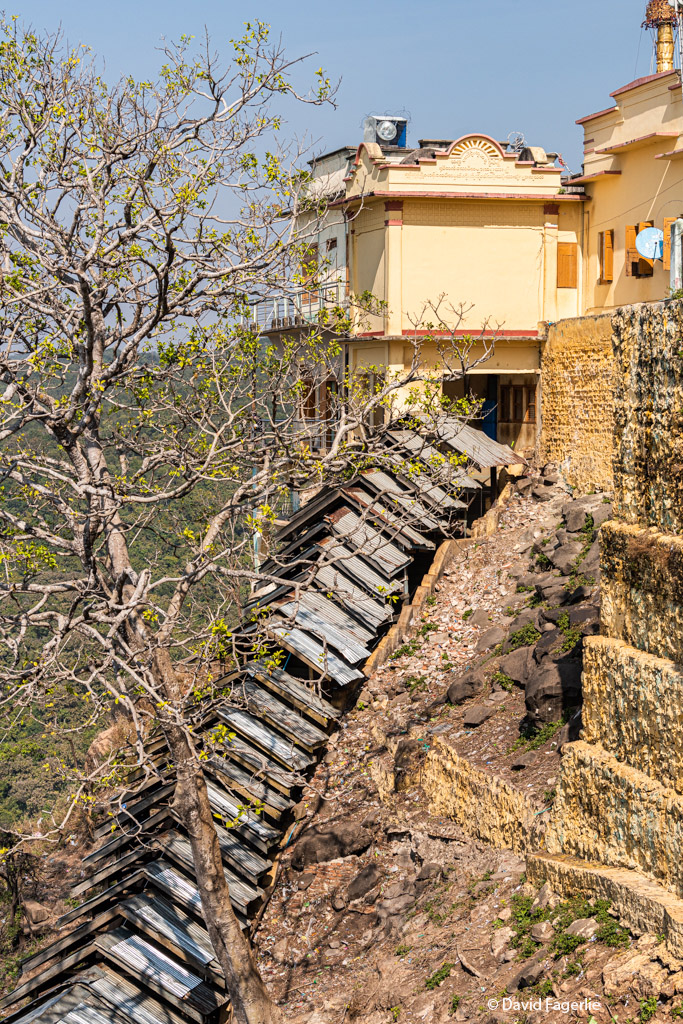


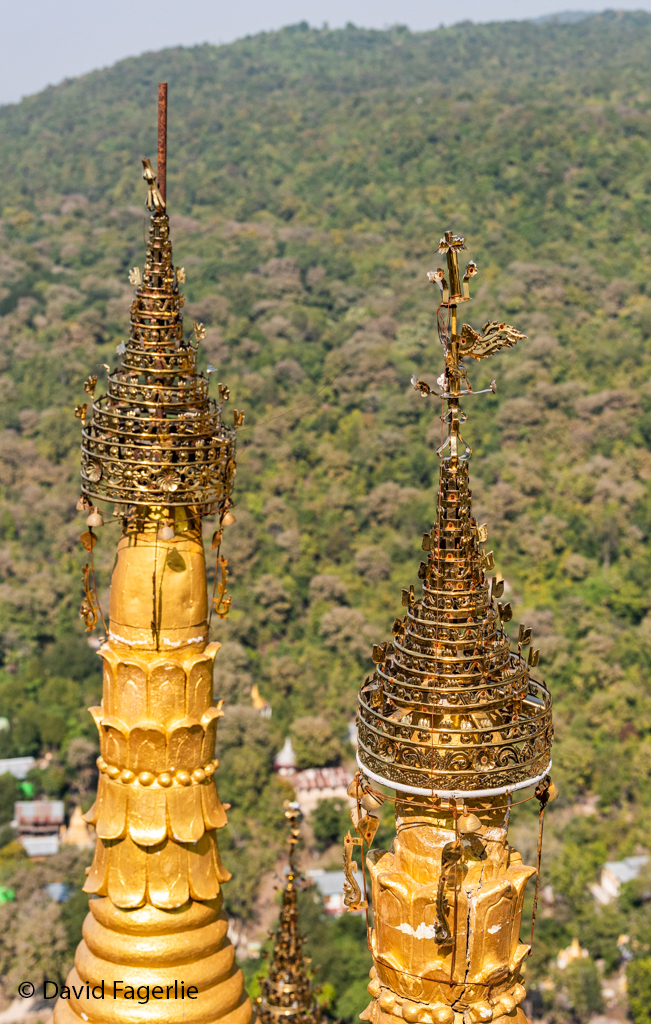
There were interesting views of a couple of small towns from the monastery. Note the concentration of religious monuments in these small communities.
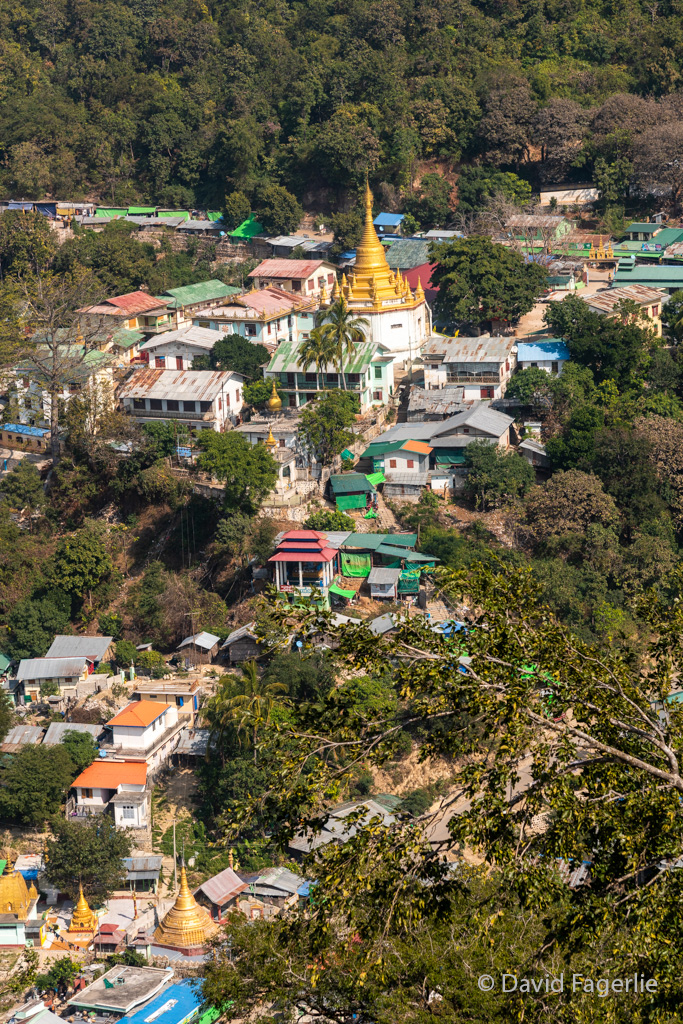
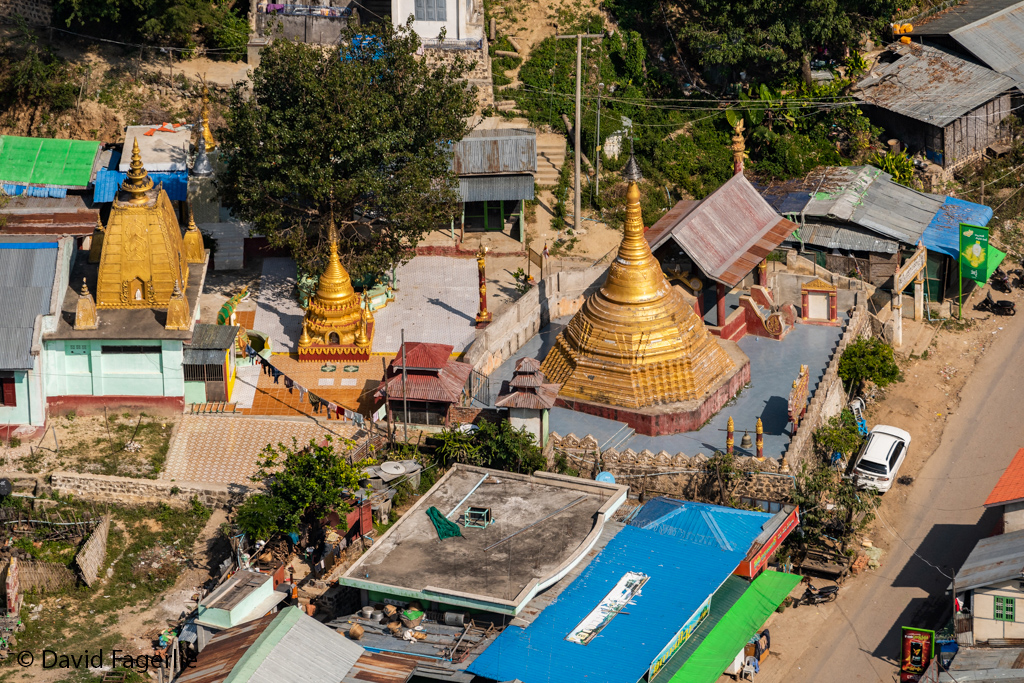
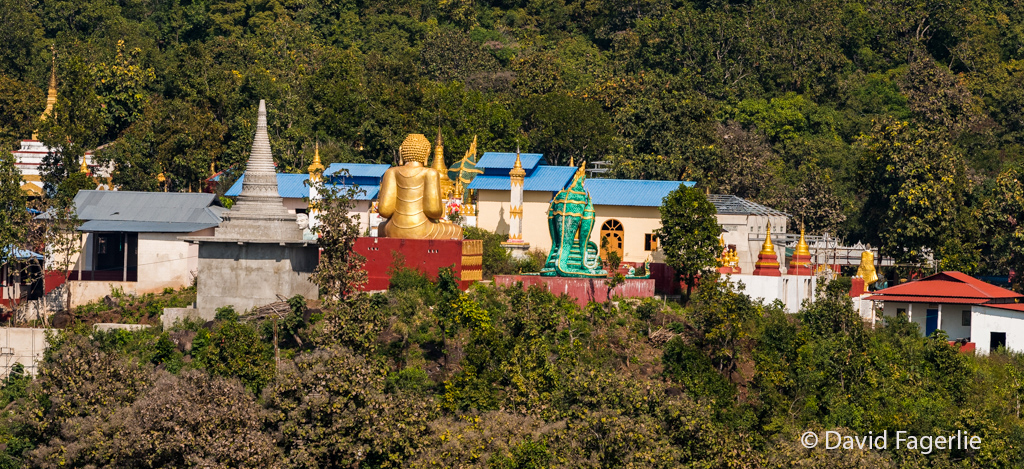
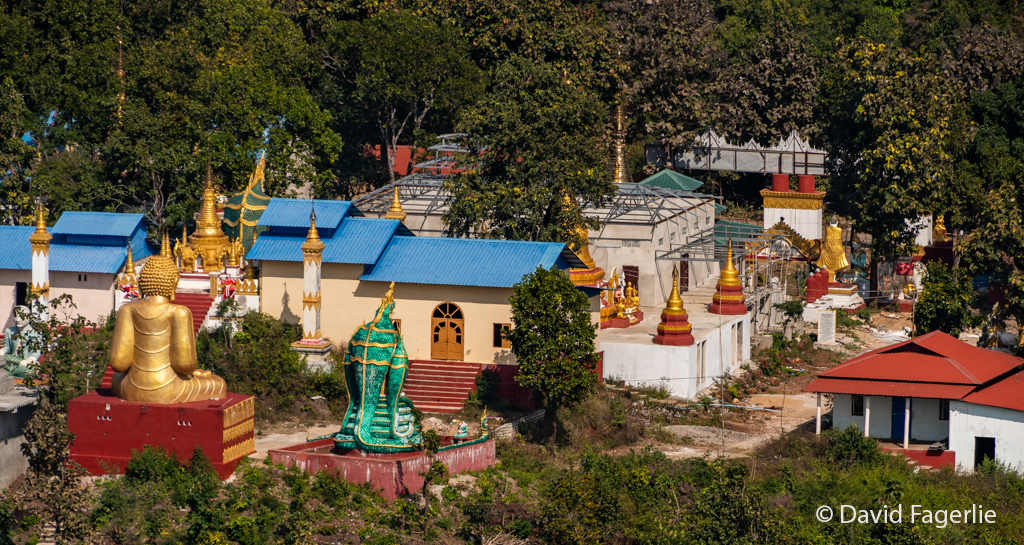
Higher resolution images in this chapter are available in the Galleries section. You can access the gallery for this chapter directly by clicking HERE.
Next Monday we visit Kalaw, Inle Lake and Indein. Please bring a flotation device; you might need it.
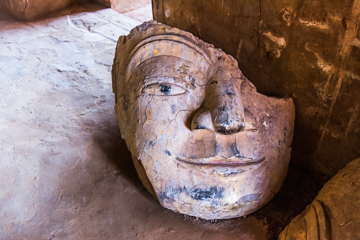
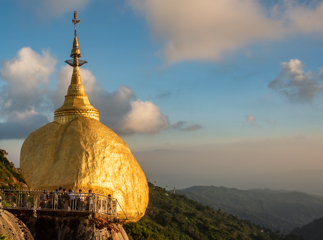
September 07, 2020
Chapter 4: Inle Lake
From Bagan we flew to Heho, the closest town to Kalaw with an airport, where we were starting this part of our journey.